Table of Contents
THE MADRASAH AL-ZĀHIRĪYAH lies just over half a kilometer south of Aleppo's southernmost gate, the Bâb al-Maqâm, south of the road leading into the heart of the Maqâmât cemetery.1
Today there does not seem to be much else to recommend the site of this institution nor the other grand Ayyûbid madrasahs between the Bâb al-Maqâm and the Sâlihîn cemetery. Rana Jalabi-Holdijk has written a fine overview of the urban development of this quarter of Aleppo that shows otherwise.2 Before the extramural street pattern was changed during the past century, the main road that left the Bâb al-Maqâm for the south ran southwest and crossed the Quwayq at a bridge called Jisr al-Hâjj, joining there the road south from the Bâb Antakîyah, and passing along the way the Maqâmât and Sâlihîn cemeteries, the Madrasah al-Zâhirîyah, the Madrasah al-Kâmilîyah, the Madrasah al-Firdaus, and other funerary monuments. This, of course, was the route by which the yearly pilgrimage departed to great celebration, as in Damascus and Cairo. Jalabi-Holdijk points out that in the Ayyûbid period this road was more formal and ceremonial than today, leading from Citadel and the grand, wide, and triumphal Bâb al-Maqâm, and that it was less used by commercial traffic than the road from the Bâb Antakîyah. Processions departed from the city through the Bâb al-Maqâm for the extramural Maqâm Ibrâhîm on significant days in Aleppo's religious and political calendar. Thus these Ayyûbid madrasahs were most seen on occasions when state and religious issues were most before the attention of the public.
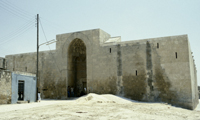
Figure 1. Madrasah al-Zâhirîyah, general view.
The building has no inscriptions, but Ibn Shaddâd provides a plausible date for it:
The Madrasah al-Zâhirîyah was founded by the Sultân al-Malik al-Zâhir Ghiyâth al-Dîn Ghâzî b. Yûsuf b. Ayyûb, Lord (sâhib) of Aleppo, and its construction was completed in 610/1213–14. A tomb (turbah) was established on one side of it and reserved for the burial of rulers and military leaders. It [the institution, not the construction] was entrusted to the supervision (nazar) of the qâdî Bahâ' al-Dîn Abu'l-Muhâssin Yûsuf b. Râfi` b. Tamîm, known as Ibn Shaddâd [appointed qâdî, wazîr, and privy counsellor by al-Malik al-Zâhir upon his accession, credited by Ibn Khallikân with developing madrasahs in Aleppo3] and Sharaf al-Dîn Abû Tâlib b. al-`Ajamî [the founder of the Madrasah al-Sharafîyah, q.v.]. It was stipulated that the latter share this responsiblity with the qâdî Bahâ' al-Dîn during his lifetime and that he should hold it alone after the qâdî's death, then it should pass to his successors.
The first to teach there was Diyâ' al-Dîn Abu'l-Ma`âlî Muhammad b. al-Hasan b. As`ad b. `Abd al-Rahmân b. al-`Ajamî. On the day of his inaugural lecture the Sultân al-Malik al-Zâhir attended in person.
Ibn al-Shihnah and Sibt b. al-`Ajamî add nothing relevant to the period of the building's foundation. Ibn al-Shihnah gives the date of completion as 616, but this date, three years after al-Malik al-Zâhir's death, is evidently the result of a scribal error (repeating the word sanah, “year,” which looks like sittah, “six”). Sibt b. al-`Ajamî gives the correct date, 610/1213–14.
Herzfeld argued that the madrasah was not entirely completed, but only the surround of the portal seems definitely unfinished. The building was opened for use, its staff was evidently paid for their work, and the succession of the superintendency settled, all during the lifetime of al-Malik al-Zâhir. As there are no foundation or waqf inscriptions, the madrasah may have begun operation without a proper endowment, which may have been established only after al-Malik al-Zâhir's death by Shihâb al-Dîn Tughrîl, the atabeg of al-Malik al-Zâhir's son al-Malik al-`Āzîz, who completed the Sultânîyah. (See the discussion in Chapter Three, s.v., Madrasah al-Farrûkhshâhîyah.) There was certainly a waqf later, as Sibt b. al-`Ajamî mentions it.4
The overall layout of the madrasah is symmetrical, with the bay of the portal centered in the north exterior wall. The building is oriented strictly to the cardinal points, showing that it was probably built on open terrain. Past the entry a small îwân-hall opens onto the north arcade, flanked by somewhat larger îwân-halls. Beyond the arcade is a rectangular courtyard with ablaq pavement and a rectangular basin. Another arcade separates the courtyard from the prayer hall, which consists of three vaults and has a rather strongly projecting mihrab, not unlike that of the Mashhad al-Husayn.5 This projection might be thought of as a buttress, especially as the ground slopes away to the south.
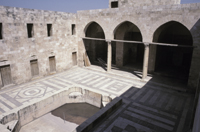
Figure 2. Courtyard.
A large îwân-hall occupies the center of the east wing. There is a stairway in the south part of this wing, along with other rooms of indeterminate purpose. In the southeast corner is a square room with double doors to the adjoining prayer hall; this is presumably a tomb chamber. Another such chamber fills the southwest corner, and is open to two similarly sized vaults occupying the south half of the west wing—a tomb chamber larger than the prayer hall. The north half of the west wing is divided into two stories of cells, each composed of two ranges separated by a central corridor. A pair of utility rooms occupies the northwest corner. The north half of the east wing is less well preserved, but might have held more cells. Much of the facades of the courtyard was missing by the time of the earliest photographs.
The exterior, which was not so ruined as the interior, is severely plain. Only the projecting mihrab and the portal, which projects three centimeters and rises above the top of the walls by several meters, break the stark confines of the outer walls. There is not even a cornice to relieve the plainness of the wall. This plainness is the impression obtained from nearby, but it may be better to take into account the formerly open context of the building: the portal and exaggerated mihrab were more visible from a distance, and the domes and rooftop staircases, obvious in a long view, would have seemed part of the building's overall shape. If so, the Madrasah al-Zâhirîyah, like the Citadel, shows the Plain Style applied on a grand scale and to good effect.
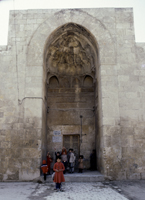
Figure 3. Portal.
The portal might be more impressive were it not on the permanently shaded north side of the madrasah. Seldom is there any direct sunlight on the portal, and then only on its outer plane. Yet this was a strong portal design, perhaps novel in the height of its almost plain lower section, its frontal arch carved with strapwork on two faces, and its gored muqarnas vault.
The doorway is topped by a plain monolithic lintel, tightly joined with the other masonry of the lower walls of the entry. Two courses above the lintel recessed rectangles in thin chamfered frames occupy the centers of the three sides of the bay; these were evidently meant for inscriptions. Above the lintel, rising through these two courses, is a slotted relieving arch of three stones so like in material and finish, and so tightly fitted, as to appear monolithic.
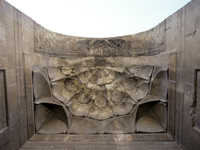
Figure 4. Portal, vault from below.

Figure 5. Portal, frontal arch.
Above the recessed rectangles the wall continues plain for the height of a short course. Then comes a doubled grooved molding that runs beneath the muqarnas vault, the frontal arch, and out onto the outer face of the portal. On the outer face this molding turns upward short of the outer edges of the frontal arch and stops, evidently unfinished. As the role of the molding is to contain visually the entire vault, including the frontal arch, it is hard to imagine how it was to be handled on the portal's outer face when completed.
Another molding surrounds the muqarnas vault only: it is a moderately wide, plain, slightly raked strip, which has the effect of reducing the size of the area to be vaulted and making the enclosed volume more rounded.
Outside this raked molding is the frontal arch, which begins only at the level of the middle of the lower tier of muqarnas, leaving plain stone between its lower ends and the grooved molding that encompasses both it and the muqarnas (also unfinished areas?). The frontal arch has its own molding, which runs along the back of its soffit, out under the ends of the arch to the outer face of the portal, along the ends of the arch on the outer face, and up around the extrados of the frontal arch, surrounding the arch's outer face and soffit but not dividing them.
The three-tiered muqarnas is rather curious, best understood as an attempt at extending the gores of the apical conch down into the tiers of muqarnas cells. This effect is created by aligning the axes of the two topmost tiers rather than alternating them as is usual. The lowest tier is much deeper than those above it, and its deep squinchlike corners set up the dodecagonal geometry of the upper portion of the vault. The second tier, while almost as high, alternates shallow cells with brackets. The points of these brackets and those in the tier above them are aligned with the ribs between the gores of the apical conch. The third and topmost tier of muqarnas is shorter, while projecting as far as the second tier; it is composed of alternating brackets and conches, or gored cells. Above this tier the apical conch rises in three short courses (why not one or two?), not quite filling the pointed arch formed by the outer segment of the portal's vault, leaving a scalloped lunette on either side, as at the Mashhad al-Husayn.
In terms of the “Muqarnas Questionnaire” in Appendix A, the muqarnas of the entry vault of the Madrasah al-Zâhirîyah is twice as wide as it is deep, but is set behind a frontal arch that gives the bay almost square proportions; it springs square, without corner brackets, and rests on a modest molding that hardly counts as a cornice; the back corners are squinchlike, filled with two cells at right angles; there are three tiers, decreasing in height and variable in width; the geometry is dodecagonal; there are branched brackets but no rolled square brackets; there are gored conches; there are no recessed domelets or “flues,” but the extension of the goring of the semidome at the top of the vault down into the muqarnas gives something of the effect of “flues”; the exterior arch (here the raked molding) is a smooth pointed arch, treated as a frame, that does not follow the outer contour of the muqarnas, and there is a decorative archivolt.
The outer face and soffit of the arch are carved with a strapwork star pattern in a hexagonal geometry (corresponding to the dodecagonal geometry of the muqarnas vault). Remarkably, on the outer face the pattern is arranged so as to suggest the presence of nine and two halves voussoirs, widely separated, with an outer ring of ten thin voussoirs. On the soffit side, the illusion is of ten boxes set back from the outer edge of the arch.6
In the space between the two illusionary rings on the outer plane of the front arch, at its apex, a small inscribed polygon contains what must be the architect's signature. Unfortunately that inscription is not very legible. Herzfeld read the name as “Yûsuf b. al- … hi”, suggesting that the last word might be “Ibrâhîm.” As read, I cannot match this with the name of any other known architect. Because Herzfeld was not infrequently inexact in his readings, I am willing to make a stretch and identify this Yûsuf with the Yûsuf b. Abû Bakr who is credited in its foundation inscription with the construction of the Maqâm of Shaykh Fâris, which according to another inscription should have occurred soon after 601/1205. That other inscription records the death of “al-`Abd al-Salâh, head of the brotherhood (shaykh al-tarîqah), Abû Bakr, the guidepost (al-nusbah),” who was the first architect of the Madrasah al-Sharâfîyah. The coincidence of profession, the fact that the Maqâm of Shaykh Fâris was built only five years before the Zâhirîyah, and the short span of years within which all the works I can attribute to Yûsuf fit combine to suggest the appropriateness of this conclusion.7
Frontal arches framed in this manner and specially decorated are known from the twelfth century: the archivolts of the east courtyard facade of the Great Mosque of Aleppo, the Baptistry at Jubayl, and the Qubbah Yûsuf on the Haram al-Sharîf in Jerusalem all have such archivolts,8 but they are carved in strong relief rather than in flat strapwork. The flatness of this frontal arch invites comparison with the frontal arch of the îwân-hall of the Mashhad al-Husayn.
Strapwork star patterns also appeared on Ayyûbid portals in the twelfth century in the Madrasah al-`Ādilîyah in Damascus and in the Madrasah Abu'l-Fawâris in Ma`arat al-Nu`mân, but so far as I can determine, this is the first instance of a strapwork frontal arch or archivolt in Syrian architecture, and it is quite an involved exercise. This frontal arch is another place where color may have been applied to a pattern carved in stone, in this case to distinguish the illusionary voussoirs in the manner of ablaq.
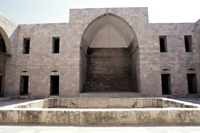
Figure 6. Īwân-hall.
The visitor who passes through the portal and short vestibule bay behind it enters the northern arcade (reconstructed since Herzfeld's day) and gains a view of the courtyard. To the left is the wing containing the large îwân-hall; its facade, which is almost totally modern,9 is absolutely devoid of ornament. To the right is a facade in which even the original portion is plain. Immediately ahead, however, is a colorful ablaq pavement of marble and basalt, the rectangular basin, and the arcade that precedes the prayer hall.10
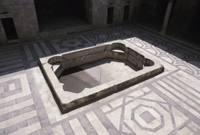
Figure 7. Basin.
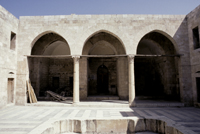
Figure 8. Prayer hall arcade.
Herzfeld documented part of the original pavement, the interlacing octagonal grid next to the prayer hall arcade. This pattern is the most complex of any such up to this date, but there is no assurance that this section was original, nor that the rest of the pavement as restored matches the original design. The basin, with the usual corner cusps, is rectangular, not square as Herzfeld drew it, and is centered on both axes of the courtyard.
The arcades paired at the north and south ends of the courtyard emphasize the courtyard and themselves as the focal points of the building, while greatly reducing the visibility of the tall arched openings of the prayer hall facade and their presumably decorated wooden doors.
Some earlier Syrian madrasahs have lateral arcades (the Madrasah al-Shadhbakhtîyah, for example), but as Creswell remarked, this is the first triple-arched arcade before a prayer hall. (Unless, as Jalabi-Holdijk points out, the first phase of the Madrasah al-Sharafîyah included such an arcade.) Following it, in Aleppo, the Madrasah al-Firdaus and the reconstructed Madrasah al-Sharafîyah also have arcades in front of their prayer halls. This use of the arcade appears as a considerable innovation. However, arcades must always have existed in Aleppan architecture, if only in secular buildings; as so many religious buildings are lost, it is hard to see these arcades as quite so innovative as the preserved record suggests.
However, arcades are expensive, especially if they use columns, and it is worth wondering about these arcades as a fashion, if not as an innovation. Such a fashion may involve imitation of a respected prototype. Prof. Bernard O'Kane has suggested to me several possible Egyptian and Western Islamic prototypes for arcades before a prayer hall. In this case I am more taken with the Aqsâ Mosque in Jerusalem as a possible source for the arcade before the Madrasah al-Zâhirîyah's prayer hall, if there was one at all.11
The pre-Crusader Aqsâ, Aqsâ II in Robert Hamilton's terminology, had no arcade.12 Its facade resembled that of the Great Mosque of Damascus, if Hamilton's reconstruction is accurate. The Crusaders identified the site of the mosque as that of the Palace of Solomon, and under the Knights Templar it was expanded and remodelled.13
Hamilton argued convincingly that the first version of the Aqsâ's arcade was constructed by the Crusaders14 and reconstructed in 614/1217–18 by al-Malik al-Mu`azzam `Īsâ, as an inscription states. In its Crusader state, it was thus available as a source from the moment Salâh al-Dîn liberated Jerusalem, and the fact that it was not demolished until it was reconstructed, soon after the completion of al-Malik al-Zâhir's madrasah in Aleppo, shows that it was accepted as part of the rededicated mosque.
If the Aqsâ arcade were the source for the Madrasah al-Zâhirîyah's arcade, or a series of such arcades—and I do think the idea somewhat fanciful—it would indicate a relationship between Crusader and Islamic architecture that is the inverse of the one I documented in A Classical Revival in Islamic Architecture: that the Crusaders, particularly the Normans, borrowed Islamic motifs of architectural decoration, ignorant or uncaring that they were not from Christian buildings, caring only that they were from the Holy Land. Here an architectural device employed by the Crusaders would have been adopted by a Muslim sultan after the reconquest of Jerusalem because it was part of a respected prototype.15
The Zâhirîyah's arcades are reminiscent of Jerusalem in yet other way: their use of tie beams, common in Palestine but rare in northern Syria. These beams were evidently just planks, passing between the capitals and the springing of the arches, and extending to anchoring slots in the piers at either end of the arcade. Fragments of wood remained at these points before reconstruction of the building. Perhaps the bodies of the tie beams were enlarged and stiffened in some manner; otherwise they must have sagged conspicuously. The capitals and bases of both arcades are Crusader spoil, the monolithic columns Antique.
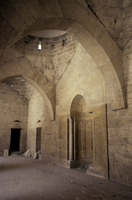
Figure 9. Prayer hall, interior.
The prayer hall is composed of three domed bays, their vaults resting on simple split pendentives. The central dome is a restoration, but it too was built on simple split pendentives, without muqarnas. What were once windows in the south wall have been filled in.
The mihrab is carved in the stones of the wall, most of it in marble blocks included for the purpose. It is an elegant composition of the genre of the mihrab in the Maqâm Ibrâhîm at Sâlihîn.
A strong molding frames the mihrab below the niche head, wrapping around, in the north Syrian fashion, the cylinder of the niche and panels to either side. The molding cuts off the niche head from the cylinder, which is filled with tall outlined panels enclosing horseshoe arches in relief. The side panels are carved with a strapwork star pattern (in an octagonal geometry). All this is marble.
Above the strong molding, in the limestone of the main wall masonry, an incised molding outlines the arch and a panel enclosing it, forming a simple knot at the top center.
Again there is no indication that the mihrab was colored, but, as at the Mashhad Husayn, the use of the very stone of the wall suggests that paint over a coat of plaster might have been intended for the final finish.
In the three-domed tomb chamber that al-Malik al-Zâhir built for the burial of rulers and military leaders, which occupies the south end of the west wing, the two end bays are covered with domes on split pendentives, like the prayer hall. But the central dome has muqarnas pendentives, supporting a octagonal cornice. Sixteen alternating niches and arched windows at the base of the vault corbel inward to a circle. The vault has been rebuilt since Herzfeld's day, but he reported that it was of brick laid “en hazâarbâaf, treillis,” that is, in some herringbone or perpendicularly patterned lay. The decoration given to this dome makes it the second most ornamented chamber in the building. A peculiarity of the pendentives is that the single cell of the lowest tier is aligned with the middle cell of the middle tier, contrary to rule and similar to the alignment of cells in the portal's muqarnas.
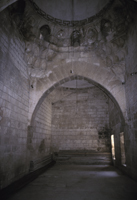
Figure 10. West wing, central vault of south chamber.
This middle bay could be entered through a door in the southern arcade. Above this door, on the arcade side, a small panel was cut but not inscribed. The northern bay had two windows onto the courtyard, which commonly signified the presence of a tomb.
I have not seen the chamber with a brick dome on squinches, at the southeast corner of the building, but Herzfeld described it and published a photograph of it. It is notable that this chamber employs ordinary squinches, springing from muqarnas cells, as this was an unusual device in Aleppan architecture of this date. This was presumably a tomb, but the point of having a second tomb chamber is unclear.
As this funerary madrasah was built by al-Malik al-Zâhir, and Ibn Shaddâd says that it was reserved for the burial of rulers and military leaders, it is reasonable to see it as al-Malik al-Zâhir's intended tomb. The Madrasah al-Sultânîyah, where he was in fact eventually buried, was founded immediately after the completion of the Madrasah al-Zâhirîyah, but without the tomb chamber in which al-Malik al-Zâhir now rests. That chamber was added after his death, indicating that the Sultânîyah was not intended by al-Malik al-Zâhir as a funerary institution. The location of the Madrasah al-Zâhirîyah on the road leading south, which was not only the road taken by pilgrims to Mecca but also the road taken to Jerusalem, may give some color to my idea that there was an intended iconographic relationship between the courtyard arcades and the porch of the Aqsâ Mosque. The use of spolia in the arcades would then be a touch of verisimilitude, and one could imagine the building as somehow a local equivalent of Jerusalem itself.
In appearance, this is another building in the Plain Style, with decoration restricted to the focal points of the building, and in part effected through ablaq. The lower part of the portal is plain in the extreme, the courtyard elevations are adorned only by the spolia of the arcades, there is not even a muqarnas capital among those of the arcades, the prayer hall has no muqarnas at all, and despite the mihrab, the prayer hall seems almost less ornate than the center bay of the tomb chamber, with its muqarnas pendentives.
The portal is a most original composition. The decorated frontal arch is new, the use of a molding to separate the muqarnas from the rest of the vault is new, and the arrangement of cells to form large flutes through vertical alignment (seen also in the central dome of the large tomb chamber) is unprecendented. The seven-gored cells are notable as a possible habitual detail. The contrast in vaulting between the center bay of the large tomb chamber and the presumed tomb in the southeast corner is also a significant detail.
Assuming that these significant details identify the work of the architect Yûsuf, two other monuments can be associated with him: the north wing of the Mashhad al-Husayn (built under al-Malik al-`Azîz, following 613/1216), and the Upper Maqâm Ibrâhîm in the Citadel. In the Mashhad al-Husayn north wing there occur not only the vertical alignment of cells and use of seven-gored cells, in the muqarnas pendentives of the western chamber, but also the contrast of muqarnas pendentives and plain squinches, in the eastern chamber. In the Upper Maqâm another strapwork frontal arch occurs, in the mihrab, and the prayer hall is plain, lacking muqarnas and employing only split pendentives in the vaults.
But that is all. I can find no other buildings attributable to the same hand, and these buildings are nearly contemporary with each other. As the Madrasah al-Zâhirîyah and the Upper Maqâm were as important to al-Malik al-Zâhir as the set of monuments built by Thâbit b. Shaqwayq, and as Yûsuf worked for al-Malik al-Zâhir's successor on an important monument (the Mashhad al-Husayn), it is just possible that Yûsuf became al-Malik al-Zâhir's leading architect following Thâbit's death. Of the other known North Syrian architects of the period, Qâhir b. `Alî b. Qânit al-Sarmânî was in Damascus and Busrâ working on military construction projects for al-Malik al-`Ādil between about 597 and 612/1200–1215, and does not seem to have worked in Aleppo again; neither of the architects of the Madrasah al-Sharâfîyah (see below), `Abd al-Salâh and Abu'l-Thanâ' b. Yâqût, seems to have built anything else that survives. However, I am not prepared to attribute the other major monument of the end of al-Malik al-Zâhir's reign, the Madrasah al-Sultânîyah, to Yûsuf or anyone else, so my picture must remain somewhat murky. It is also worth noting that the vertical alignment of muqarnas cells was not exclusively a practice of Yûsuf: it occurs in the portal of the Khânaqâh of Dayfa Khâtûn (Khânaqâh fi'l-Farâfrâ) portal and in Damascus, in the portal of the Madrasah al-Sâhibah. One could make an argument for attributing the former monument to Yûsuf, but I am not prepared to do so.
Portal. The portal projects 3 cm. The slotted relieving arch springs over the corners. The back of the bay is not in bond with the lateral sides. Course heights, east side of portal: partly buried, 60, 53, 52.5, 45, 55. The stones are extra fine, orange-patinated whitish limestone, stained with red in places. The lintel is smooth faced.
Exterior. Course heights, exterior wall, east of portal: partly buried, 32, 31, 31, 32, 30.5, 31. All stones are extra fine to finely smoothed with untoothed tool, some medium toothed medium stroke.
The finish of the interior includes roughly smoothed with an untoothed tool, medium smoothed with untoothed tool, and finely smoothed with untoothed tool (especially in the prayer hall lintels), also some medium toothed, medium to long stroke finish. The prayer hall is rough enough that it must have been intended to plaster it. Course heights of west pier of prayer hall: 78 (partly buried?), 37, 36, 36, 36.
The Madrasah al-Sultânîyah, originally called the Madrasah al-Zâhirîyah, should have been the defining religious monument of al-Malik al-Zâhir's reign, but it never was finished properly.16
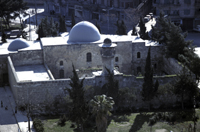
Figure 11. Madrasah al-Sultânîyah, view from Citadel.
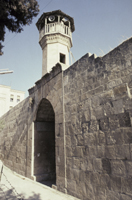
Figure 12. Oblique view of portal.
The madrasah stands below the Citadel, south of the upper entry block and immediately east of the barbican. A space of perhaps thirty meters separates its north facade, where the portal is, from the line formed by the other buildings around the moat. Most of this space must have been occupied by some other building, perhaps the Khânaqâh al-Qasr (see Ibn Shaddâd, quoted above in Chapter Five, s.v., Aleppo Citadel Entry, “The Citadel and the Eastern City Wall”), separated from the madrasah by a lane.17
The portal and the north facade were proportioned for viewing from this lane, and the fine view of the building that can be obtained from the upper entry block of the Citadel seems not to have been considered.
There are two inscriptions on the portal, one on the cyma cornice of the portal block, and the other occupying three sides of the entry bay, in four to five lines. The latter inscription furnished much, but not all, of Ibn Shaddâd's remarks on this building:
The Madrasah al-Sultânîyah, opposite the Citadel, common to both the Shâfi`îyah and the Hanafîyah. Al-Malik al-Zâhir had founded it (assasahâ) before he died in 613/1216, but it was unfinished. It remained so for a time after his death, until Shihâb al-Dîn Tughrîl, the atabeg of al-Malik al-`Āzîz [who was then ruling], took up the project and built it and adorned it (`ammarahâ wa kammilahâ) in the year 620/1223–24. The qâdî Baha' al-Dîn b. Shaddâd taught there and inaugurated it, teaching there just one day, that is, Saturday, 18 Sha`bân of the same year [620/1223–24].
Ibn Shaddâd fails to mention al-Malik al-Zâhir's tomb, as does Ibn al-Shihnah, who merely repeats most of what Ibn Shaddâd has to say, adding that the inscription on the portal (bâb) states that it was endowed for both the Shâfi`îyah and the Hanafîyah.
Ibn al-`Adîm reports that
the Sultan al-Malik al-Zâhir was translated from the chamber (hujrah) in which he had been buried, in the Citadel, to the tomb (qubbah) in the madrasah that the Atabeg had built for him, and he was buried in it on 1 Sha`bân 620/1223.
Sibt b. al-`Ajamî adds only praise and details of the institution's waqf and later scholarly tradition, up to the time of Tîmûr.
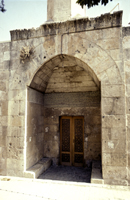
Figure 13. Portal, view to south.
Both of the inscriptions on the portal cite a date, 620/1223–24, which must be that of completion, not foundation. As the Madrasah al-Sultânîyah was unfinished at al-Malik al-Zâhir's death three years after the Madrasah al-Zâhirîyah extra muros was completed and inaugurated in 610/1213–14, it could well be that the Sultânîyah was begun only after the Madrasah al-Zâhirîyah was completed, and that, again, a single stream of revenue was devoted first to one building, then to another.
The design date of the Sultânîyah was thus before 613/1216, and probably after 610/1213–14, when the Madrasah al-Zâhirîyah was completed and al-Malik al-Zâhir could turn his attention and architectural funds to this project. The Sultânîyah was then completed, in a second campaign, by 620/1223–24, when al-Malik al-Zâhir was translated to his tomb there.
The inscription on the cavetto cornice of the portal says that it was founded (ansha'a) for the recitation of the Qur'ân and the study of religious law, during the reign of al-Malik al-`Azîz Muhammad (who was then still a minor), including the tomb of his father, al-Malik al-Zâhir Ghâzî; it was built under the supervision (bi-tawallî) of al-Malik al-`Azîz Muhammad's regent, Shihâb al-Dîn Tughrîl, and was finished in 620/1223–24.
The verbose inscription that occupies three sides of the entry bay begins with Qur'ân 9:18, usually applied to mosques, and then says that the construction of this madrasah was pursued, and it was founded (ansha'ahâ), during the reign of al-Malik al-Zâhir.18 The inscription calls for Allâh to perpetuate the sultanate of al-Malik al-`Azîz, the son and successor of al-Malik al-Zâhir, indicating that the inscription was written and executed in his reign. Then, flatly, it says that it [the institution] was [re]founded (ansha'ahâ) by the atabeg Shihâb al-Dîn Tughril, upon whom it lavishes praise. The inscription concludes with various stipulations about the ordering of the madrasah's affairs. This inscription ran so long that it overflowed its panel.
This inscription confirms Ibn Shaddâd's account entirely. The tomb chamber bears additional inscriptions on the lintels of its windows, which say that it is the tomb (turbah) of al-Malik al-Zâhir, with pious invocations that indicate he was dead when the inscriptions were composed.
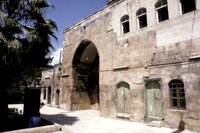
Figure 14. Courtyard, north wing.
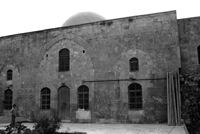
Figure 15. Courtyard, prayer hall facade.
It is possible to imagine the madrasah's intended form. From the account of J. Lauffrey, who restored the building after 1944, it is clear that the east wall of the prayer hall was altered when the tomb was added. As the tomb was built only during the second campaign, the prayer hall must be of the first campaign, under al-Malik al-Zâhir. The north wing is probably also from the first campaign, though the portal was not inscribed during al-Malik al-Zâhir's lifetime. Left unbuilt in the first campaign were the east and west wings. Here one would expect to find cells and an îwân-hall, probably planned for the east wing, the location on the courtyard most favored in Ayyûbid madrasahs except for the north side, which was occupied here by the portal. In the event, the second campaign supplied the planned rows of cells in the west wing and substituted for the expensive îwân-hall another wing of cells. (The east wing was completely ruined until rebuilt by Lauffrey.) Some of these conclusions were reached by somewhat varying routes by Herzfeld and Lauffrey.19
The argument for a planned îwân-hall is simply that no other madrasah of the period lacks one. Herzfeld ignored this matter. Creswell saw that an îwân-hall must have been planned, and, wandering down one of the paths of the false four-iwan madrasah problem, decided that as the madrasah was common to two schools of law there actually had been constructed two îwân-halls, one each in the east and west wings. Lauffrey was content with the lack of any îwân-hall, even attempting to situate this anomaly within the four-iwan problem.
Surely an îwân-hall was intended; whatever the îwân-hall was actually used for, it was one of the distinguishing marks of a Syrian madrasah. Just as surely, in the case of the Sultânîyah, none was ever built, else some of its heavy masonry would have been uncovered by Lauffrey. Instead, Tughrîl simply completed the rectangle of the building and built the tomb, in order to finish off the project and get al-Malik al-Zâhir properly buried. There is no reason to believe that two îwân-halls were intended; there would have been no room for cells had both east and west wings been so occupied. The original plan was thus probably to construct an îwân-hall on the east side of the courtyard.
The portal of the Sultânîyah is as understated as any Ayyûbid portal, in part because of its position away from main streets. Perhaps for this reason it is also an excellent example of fine masonry finish: just as with the Madrasah al-`Ādilîyah in Damascus, the viewer was necessarily close enough to the stones to appreciate their finish. The portal projects only two cm. from the north exterior wall, as though it were a separate piece of masonry, but this is not the case: every other course crosses this apparent break, but with a shift in dressing meant to emphasize the separateness of the portal block. The portal is crowned with an inscribed cavetto cornice.
The door frame is plain, and there are small benches on either side of the bay. Above the monolithic lintel is a slotted relieving arch, also, I believe, monolithic. An inscription band of four lines, containing the long inscription discussed above, runs around all three sides of the bay above the lintel, and another line has been allowed to lap onto the top of the lintel itself.
Above the inscription band the entry bay is covered with a mitered vault extended by short section of barrel vault. The upper line of the inscription band is cut up into the springing of the vault.
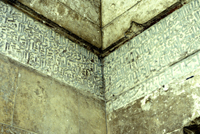
Figure 16. Portal, detail of inscription.
As Herzfeld remarks, the arch appears depressed or splayed because, as usual, the exterior is concentric with the intrados, and the intrados has been truncated at its base by the inscription band. The original inscription must have been planned to be one line shorter, but even with the added line the inscription burst the bounds of its panel on the left end, where letters are cropped and one of them laps onto the surface of the plain stone.
At the bottom, the inscription band has also been enlarged beyond what was planned originally by just a bit, so that it cuts into the course below. In the center, over the doorway, the extra line added at the top of the monolithic lintel rathers spoils the intended contrast between plain lintel and inscribed flat relieving arch.
The masonry of the entry bay is bevelled along its horizontal joints up to the zone of the vaulting, where the main joints of the vault are also bevelled. The bevel stops short of outer edge of outer face of portal by nine centimeters. The voussoirs of the frontal arch are bevelled on all sides. All the surfaces are finished to an extremely fine texture, so fine that it can be mistaken for the natural grain of the stone. The next degree of finish in fineness is sufficiently coarse to show the toothing of the adze used to produce it; to either side of the portal the set-back faces were finished with a medium-toothed tool using medium-length strokes (about a half to one cm. long).
On the courtyard side of the portal is a bay covered with a barrel vault, which has a slight notch where the arch of the bay meets the wall surface facing the courtyard. This vault shows how the exterior vault may have been planned originally. The point of setting these vaults inward slightly from the walls that support them must have been to allow wooden centering to be removed more readily.
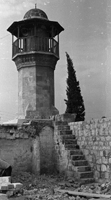
Figure 17. Minaret.
Atop the portal block a minaret's octagonal shaft rises from a square base with small pyramids of stone at the transition. The base and shaft of the minaret may be original, but everything above the muqarnas cornice is recent reconstruction, and the cornice itself looks distinctly Mamlûk.20
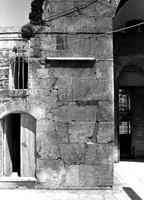
Figure 18. Original masonry in north wing.
Aside from the portal block, the existing parts of the north wing are later rebuilding, as the segmental arches of the doorways indicate. On the west side an original springer and a single voussoir are preserved, but this is the scantiest of evidence for the original plan of the north wing. Lauffrey's drawing of this elevation before some of it was removed during reconstruction shows that there was a similar arch on the east side of the entry bay, and several possibly original horizontal and vertical joints on both sides of the entry in the second story. His reconstruction is a reasonable guess at the original arrangement, which may have been completed only in the second campaign (accounting for some of those joints in the second story). In any event, this facade was apparently absolutely devoid of ornament, like the prayer hall facade.
Herzfeld and Lauffrey recorded remains of the courtyard's original large square basin, cusped at the corners as usual. Lauffrey mentions no trace of the original pavement of the courtyard.
In 1979, before the most recent reconstruction, a small collection of basalt column elements was to be seen in the courtyard, but it is anyone's guess what part of the building they belonged to. As similar elements, presumably Late Antique, were found in the Madrasah al-Shâdhbakhtîyah, perhaps they were used in foundations.
The east wing, entirely composed of cells, was entirely reconstructed by Lauffrey on the basis of his excavations, which also revealed similar structures on the west side of the courtyard. This new east wing probably reflects the plan of both east and west wings as eventually constructed by the atabeg Tughril.
The courtyard facade of the prayer hall is well preserved, except that the cornice is recent and the large openings have been filled with masonry. What is notable, aside from the complete lack of any decoration, is the hierarchical size of the three openings. This is simple and clean arrangement, eliminating the upper lights seen in the prayer hall elevations of the Madrasah al-Shâdhbakhtîyah and the Lower Maqam; it was employed in several other buildings constructed in the ensuing decades. The emphasis is entirely on the central bay.
The prayer hall has a large central dome on split pendentives, flanked by two miter-vaulted bays matching the two smaller openings in the prayer hall facade. Paired cupboards or air shafts are centered in the qiblah wall in each side bay. The mihrab is set back into a large recess that corresponds to the wide frontal arch of the center bay. The cross plan thus created is most unusual and, as Herzfeld noted, rather striking when experienced in person.
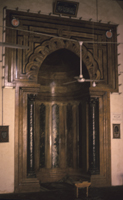
Figure 19. Mihrab.
The mihrab is another fine example of marble marquetry, with recessed panels bordered by a relief molding in the central half-cylinder, horizontal coursing in the niche head, and a well developed interlace occupying the spandrels. Columns, capitals, and bases are again contemporary.
To the east of the prayer hall is the tomb of al-Malik al-Zâhir, which projects beyond the present east wall of the building, allowing three windows to be opened on the three sides of the projection.
The tomb chamber is square, smaller than the bays of the prayer hall, but with fairly deep recesses on its axes, like the central bay of the prayer hall. The northern and southern recesses are enlarged laterally into air shafts, now closed with shutters; according to Lauffrey, the western shaft of the south side (L on his plan) actually is the start of an underground passage, which, he adds, is said to lead to the Citadel. The four modern tomb covers are inscribed to “Sultan Muhammad” and his wife and two children. A new tomb has been placed in the eastern recess since Lauffrey's day. The tomb bears a dome on split pendentives.
The monolithic lintels of the tomb's windows are topped with relieving arches that are flat above and pointed below, details of the construction varying from side to side. Their inscriptions are reminiscent of Damascene practice, as such inscriptions are seldom found in Aleppo.
The mihrab aside, this is a very austere building. Even the portal is enlivened only with inscriptions, there is no muqarnas at all, and there is hardly a molding to be found anywhere. No truer example of the Plain Style stands in Aleppo today. However, I cannot attribute it to Yûsuf or any other known architect, nor have I yet succeeded in matching its style with that of any other extant contemporary building.
Exterior. To the west and east of portal, extra fine stones that cross the setback are medium toothed medium stroke on the set-back faces. To the west the stones have pick-faced centers with medium toothed medium stroke margins, the stroke in various directions. The same is true of the exterior wall to the east of the portal, though here there are several extra fine stones at upper left of preserrved original portion, where the wall plane changes before a vertical joint in the four lowest courses. Course heights of west side of portal: partly buried, 53, 53.5, 53.5, 50.5.
Farther east the lowest courses include a few extra fine stones, medium toothed medium to long stroke, and pick-faced stones with margins. Without the extra fine finish, this masonry continues in the lowest two courses around to the tomb, which is extra fine, medium smoothed with an untoothed tool, medium toothed medium stroke, medium toothed long stroke, and pick-faced as before; pick faced stones occur between the quoins and the window frame on east side. The relieving arches are extra fine. There has been a good deal of restoration around the windows. In the east half of the qiblah wall, west of the tomb, the stones are pick faced, margined as before, with smaller entirely pick-faced stones above. The southerly jog in the qiblah wall breaks coursing except for the lowest course, which while very deteriorated has some stones medium smoothed with untoothed tool, but is mostly pick-faced, margined as before. The smaller masonry above, on the southwest side, is medium toothed long stroke, occasionally finely smoothed with untoothed tool, and, above the fourth small course, is generally pick-faced entirely.
Course heights south of east tomb window: partly buried, 55, 54.5, 54, 55.5. The quoins at the southwest corner of the building are medium smoothed with untoothed tool horizontally and vertical on the same angled (sketch) stones. There are also medium to coarse toothed, long stroke and restored stones. Course heights: partly buried, 54, 57.5, 53.5, 56.
Except for the lowest and perhaps the next course up, on the west side all stones are medium toothed long stroke prob restoration. The whole wall except for the lowest course has been drag-picked for plastering.
Portal. In the portal all stones are finished fine to extra fine, including the notches required by the enlarged inscription. The bevel stops short of the outer edge of the outer face of portal by nine cm. The lintel is also extra fine, treated like just another course. The inscription now has brown paint on letters, overlain by green, against a yellow background. The tympaum of the portal is bevelled horizontally.
Courtyard. The prayer hall facade is extra fine with occasional medium toothed medium to long stroke, possibly secondary work. The prayer hall side of the east pier is roughly smoothed with an untoothed tool with some medium toothed long stroke, again probably secondary. The back of the portal is fine to extra fine, also with some medium toothed medium to long stroke. There is no bevelling aside from the portal.
Prayer Hall. In the prayer hall, damp damage to plaster shows that the dome is brick.
Tomb. The tomb has stones roughly smoothed with an untoothed tool, medium toothed long stroke, and some medium smoothed with untoothed tool and coarsely toothed long stroke.
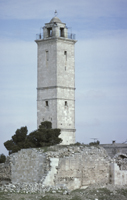
Figure 20. Minaret.
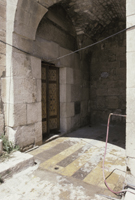
Figure 21. Portal.
In Chapter Four, s.v., Lower Maqâm, I presented the historical accounts describing both the Lower and the Upper Maqâms. The account of Ibn Butlân, who first visited Aleppo in 440–41/1049, states clearly that the Upper Maqâm was a church at the site of the altar of Ibrâhîm (or perhaps containing an object identified as that altar); he also mentions a mosque, and, strikingly, fails to mention the stone head of Yahyâ, which was discovered and brought to Aleppo in 435/1043–44, five years earlier.21
The conclusion is inescapable that the stone head of Yahyâ was housed in the mosque, which Ibn Butlân did not visit, rather than either of the churches. In his account of the Upper Maqâm, Ibn Shaddâd says that a congregational mosque was built by the Mirdâsids, and it was called the Upper Maqâm Ibrâhîm; he adds with respect to Ibn Butlân's account that “the altar on which Ibrâhîm sacrificed was later converted to a mosque in the time of the Banî Mirdâs.” The Mirdâsids ruled Aleppo between 414 and 472/1023–1079, and thus could have built a mosque before or after the Christian physician's sojourn in Aleppo.
It would be a reasonable inference that the mosque replaced the church physically, but this inference fails because Ibn Butlân saw a mosque, the later history of which is unaccounted for if it was not the Mirdâsid congregational mosque. Given that we have many Muslim historical sources and hardly any Christian ones, it is far easier to accept the undocumented disappearance of churches than of mosques. Thus the Mirdâsid mosque may have been constructed in or shortly after 435/1043–44, when the relic of Yahyâ was discovered, specifically to house that relic; in any event, it was built next to the church of the Upper Maqâm. The juxtaposition of the mosque with the existing Christian shrine to Ibrâhîm, said to have been on the site of Ibrâhîm altar, was probably an attempt to upstage the Christians with another Biblical relic. The mosque may have taken over the appellation “Upper Maqâm” in various ways. Most likely the issue was settled when the church was seized and annexed to the mosque. The other church was, as Ibn Shaddâd says, on the site of the Lower Maqâm, and was seized at an unknown date.
Herzfeld cited a passage from Ibn al-`Ajamî, s.a. 454/1062, that gives additional, though not crucial, information about the Upper Maqâm:
[Mu`izz al-Daulah Thimâl, the Mirdâsid] was buried in the Upper Maqâm (maqâm Ibrâhîm al-fauqânî) in the Citadel, inside the east entry (bâb), and they built over him a tomb cover (darîh) that remained until the time of Al-Malik Ridwân, when it was torn out and paved over.22
This passage indicates that in 454/1062 some Muslim shrine was called “Upper Maqâm.” The only surviving Mirdâsid inscription in Aleppo, which records unspecified construction by Tâj al-Mulûk Mahmûd in 465/1073, was found near the site of the Upper Maqâm and might conceivably belong to the Mirdâsid mosque.23
It was a feature of the mosque that it possessed a closet next to the mihrab in which the head of Yahyâ was kept. The mosque was repaired by Nûr al-Dîn, it burned on al-Malik al-Zâhir's wedding night in 609/1213 along with the palace, and al-Malik al-Zâhir replaced it with the present structure the following year.24 I find no trace of earlier structures in the present building, unless in the lowest courses of the minaret.
A minor point remains to clarify about the disastrous fire in the Citadel on al-Malik al-Zâhir's wedding night, 11 Jumâdâ I 609/9 October 1212, which destroyed the Upper Maqâm. Ibn Shaddâd's citation from Ibn al-`Adîm differs from the published text, s.a. 609, which runs as follows:
A fire occurred in the Maqâm Ibrâhîm, the one in which there is a minbar, the night of mîlâd. In [the building] were tents, war materiel, and weapons (khiyam wa'l-âlât wa'l-silâh) beyond description, and it all burned, nothing surviving but the reliquary (jurn) in which was the head of Yahyâ b. Zakarîyâ', although even the roof and the doors (al-suqûf wa'l-abwâb) burned. The sultan al-Malik al-Zâhir restored ( jaddada) it so that it was more handsome than before.
It is a bit odd that the Upper Maqâm, which Ibn al-`Adîm says had been restored by Nûr al-Dîn, should have been full of war materiel. Ibn Shaddâd says that the arsenal (zardkhânâ) burned along with al-Malik al-Zâhir's palace, without mentioning the Upper Maqâm by name. It is also odd that Ibn al-`Adîm does not mention the destruction of either the palace or the arsenal.25 I suspect some confusion among the historians, and conclude that the war materiel was in the arsenal, somewhere between the Upper Maqâm and the palace, and that the Upper Maqâm was in normal use as a mosque; both burned. In any event, the Upper Maqâm as built by al-Malik al-Zâhir—and drastically rebuilt in the 1980's—has a niche apparently for the relic of Yahyâ,26 which since the seventh/thirteenth century has been kept in the Great Mosque instead. In this respect the present building must reflect the form of the Nûr al-Dîn's Upper Maqâm, but the form of that version of the shrine remains otherwise unknown, except that it was probably mosquelike, as is the present building.
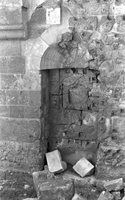
Figure 22. Niche east of mihrab.
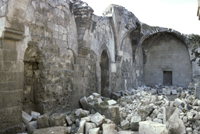
Figure 23. Interior before reconstruction.
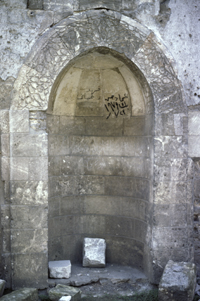
Figure 24. Mihrab.
Herzfeld's photographs show that the building's vaults and arcades, the prayer hall facade, its southeast corner, and the bay over the entry were ruined in his day.27 The shrine was heavily rebuilt in the 1970's and 1980's, after excavations laid bare the bases of the arcades
The visitor's axis of approach is the lane that extends uphill beyond the upper entry block, roughly continuing the axis of the viaduct. Because of the slope, no doorway into the shrine could be situated so as to face this axis, and the solution chosen to this problem of placement was to locate the Upper Maqâm west of the upper end of the lane, with the minaret at the very head of the lane and an entry in the northeast corner of the shrine, just south of the minaret. While Herzfeld's plan shows the minaret, the shrine, and the vaulted bay as being of the same date, the minaret is not in bond with any surrounding masonry. The portal, which projects some 10 cm. from the rest of the east wall, was made to receive the vault of the covered bay. This bay could have been made into an imposing portal, but seems to have been downplayed completely. Aside from its ablaq pavement, which may not be original, any decoration it may have had has been lost, as the entire east side of the building has been reconstructed, including the door frame of the entry. There remains a monolithic inscription panel within the lunette of the bay's vault, over the doorway.
The portal gave onto the eastern arcade. On the inside the portal doorway is a simple pointed arch composed of simple voussoirs without a keystone. The arcades, which ran continuously around the east, north, and west sides, were built of half a dozen courses of cut stone, with rubble barrel vaults groined at the corners. Parts of the present east and north arcades are original.
The building is shorter north to south than it is east to west, and the four courtyard facades are arranged in three different ways. The east and west arcades are composed of three wide pointed arches on piers, offset to the side of the prayer hall. The north arcade's openings are smaller and its piers heavier, possibly because it was thought to buttress somehow the north wall of the building, in which five doorways open into the north wall of the Citadel itself.
The prayer hall's facade on the courtyard offered only narrow openings, the same width as those of the north arcade but spaced more widely, so as to center them on the side bays of the prayer hall.
The prayer hall is composed of a central domed bay on split pendentives and two lateral wings of two groin-vaulted bays each; while nearly all the vault was lost before recent restoration, enough was preserved to be sure of these details. The vaulting springs from carved consoles. On the qiblah wall several simple rolled consoles have been preserved, and flanking the mihrab, a pair of rather disappointing muqarnas consoles. The mihrab is slightly articulated on the exterior. The cylinder of the mihrab is plain stone, its horizontal edges bevelled. Its niche head is arranged in five radial panels, alternating three recessed panels with two flush with the surface of the small semidome at the apex of the panels, recalling the mihrab of the Madrasah al-Shâdhbakhtîyah.
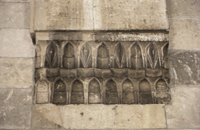
Figure 25. Muqarnas console.
The archivolt of the mihrab is cut with a strapwork star pattern in an octagonal geometry, like that on the portal of the Madrasah al-Zâhirîyah. Unlike that example, the pattern here is continuous and does not simulate voussoirs; neither are the actual stones jointed along the lines of the pattern. As with the Mashhâd al-Husayn, the fact that the mihrab is carved from the stone of the wall implies that some sort of color was painted on a coat of plaster applied to the bare stone. This strapwork archivolt and the use of plain split pendentives in the antemihrab dome are sufficient for me to assign the building to Yûsuf, the architect of the Madrasah al-Zâhirîyah, where both devices occur.
To the east of the mihrab is the niche that held the jurn, or reliquary that held the head of Yahyâ. While it was very ruined before reconstruction, it seems to have been a round-headed niche square in plan, the niche head divided into radial panels; part of the jurn may actually remain in the back of the niche.
In order to push this study toward completion, I defer a discussion of the Upper Maqâm's minaret to some future occasion. In short, it is of an established type, consists of at least two periods of construction, and is fairly plain, like the Upper Maqâm in general.
The Upper Maqâm is as prominent an example of the Plain Style as there is in Aleppo. The mihrab bay—perhaps thought of as the spot where Ibrâhîm's altar stood—has some decorated elements, and the minaret is not entirely plain, but in contrast to the lavishly decorated palaces that stood nearby, this is a plain building.
In the portal, original stones are mostly medium toothed medium stroke, with some coarsely toothed long stroke, finely toothed long stroke, and finely toothed medium stroke. A few stones have margins; some of these are medium to finely toothed medium stroke stones partially finished with an untoothed tool.
The remaining original stones on the interior of the north arcade and arcades, which it must have been intended to plaster, are medium toothed long stroke, a very few with horizontal stroke.
The muqarnas corbels flanking the mihrab are finely smoothed with untoothed tool to smooth faced, depending on the facet.
The mihrab is extra fine to smooth faced. It projects between 7 cm. at the floor to 3 cm. at its top. The upper edges are finished medium to coarsely toothed. The horizontal bevels of the cylinder, which have been filled with mortar, stop short of the leading edge of the niche by 11.5 cm. Course heights: 42.5, 30, 30, 29, 29.5, 29, vault.
The niche hood to the east of mihrab was finished medium to finely smoothed with untoothed tool.
Under al-Malik al-Zâhir the Plain Style's basic approach was maintained and developed, although Nûr al-Dîn's master architect, Thâbit b. Shaqwayq, working for al-Malik al-Zâhir, made artful use of the Ornamented Style in the Mashhad al-Husayn, the Dâr al-`Izz, and the portal of the Bîmâristân Arghûn.
Most of al-Malik al-Zâhir's buildings are neither composed of distinctly shaped parts like Antique buildings, nor of rectangular blocks that are unified and enlivened by moldings and plastic ornament like the monuments of the Ornamented Style. They are stark rectangular blocks outfitted with interior decoration: fountain, pavement, doors, window grilles, mihrab revetment, and so on. Al-Malik al-Zâhir's palace in the Citadel was remembered for just this kind of decoration, not for its elaborate portal.28
The Ornamented Style lived on most strongly in mihrab revetment, where a large repertoire of moldings and plastic ornament continued in use. Perhaps the Ornamented Style had begun to seem if not old-fashioned, then traditional. Certainly new developments such as the muqarnas and experiments with ablaq occupied the artistic attention of architects and their patrons.
Al-Malik al-Zâhir's contribution to the development of architectural style may well have been that he continued to employ Thâbit b. Shaqwayq until that architect's death, and that he built many buildings, not that he favored a particular style.
The Madrasah al-Kâmilîyah lies outside the Bâb al-Maqâm, not so far from the city as the Madrasah al-Zâhirîyah but in the same locale. It seems not to have been sited quite so prominently on the road to the Maqâmât cemetery as the Zâhirîyah. Otherwise, it is of the same scale and quality as the Zâhirîyah, but simpler.29
The building bears no inscription, and neither Ibn al-Shihnah nor Ibn Shaddâd notices a madrasah of this name in the correct location. Herzfeld was led by his ingenuity and the lack of historical evidence to attribute the building to Fâtimah Khâtûn, who married al-Malik al-`Āzîz in 627/1230, but this attribution is entirely speculative. Ibn Shaddâd and Ibn al-Shihnah30 mention two madrasahs in “al-Maqâm” that could be considered as candidates. One was founded by Bahâ' al-Dîn, known as Ibn Abî Sayyâr (the name is uncertain); the other by `Izz al-Dîn Abu'l-Fath Muzaffar b. Muhammad b. Sultân b. Fâtik al-Hamawî, completed in 662/1262–64.31 Lorenz Korn speculates nicely that the building may be the Khânaqâh al-Kâmilîyah that Ibn Shaddâd says was built extra muros by the wife of the shâdd al-dîwân (an amir charged with assisting in the collection of taxes) `Alâ' al-Dîn b. Abi'l-Rajâ', who herself was known as “al-Kâmilîyah.”32
However, nothing much is gained by pursuing any of these leads, so far as I can see. Herzfeld may well have been correct in his attribution. Indeed, such a building must have been built by someone near the top of the Ayyûbid state, and had that person been the ruler the local historians would have mentioned it—but they might well have disregarded a building founded by a woman of the Ayyûbid house or by one of its top servants, especially as it was left without an inscription to preserve the memory of its founder. In any event, the building must be considered on its own.
In plan the Madrasah al-Kâmilîyah is very like the Madrasah al-Shâdhbakhtîyah, with an entry off axis into a squarish courtyard that had an îwân-hall on the north side and arcades and cells along the east and west sides. The plan of the prayer hall was compressed so as to make room for two large domed chambers in the south corners, and the entry is through a passage built alongside the rectangle of the building rather than within it. In aesthetic conception it is like but simpler than the Madrasah al-Zâhirîyah: it has a plain exterior, a portal that is quite plain except for its muqarnas vault, ablaq courtyard pavement with a relatively small, conventionally cusped octagonal basin, plain courtyard facades without arcades, and a prayer hall that is plain except for the conventionally decorated mihrab and the muqarnas squinches of its vaults. This is what might be called a stock Ayyûbid royal madrasah, with an emphasis on large formal chambers and perhaps somewhat meager housing for staff and students. The only decoration is of entirely standard types, and no exotic or expensive elements such as columns and capitals appear.
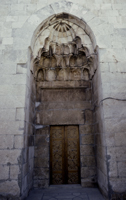
Figure 26. Portal.
The portal, which is not so tall as that of the Zâhirîyah, is plain except that a blank inscription panel framed with a strong molding is centered between the monolithic lintel of the doorway and the muqarnas vault above. The lower blocks of the inscription panel form a flat slotted relieving arch for the lintel.
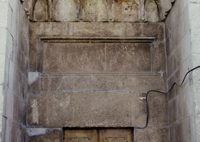
Figure 27. Lintel and inscription panel.
The muqarnas vault rises sharply through three tiers to a large and tall gored semidome. The four-gored cells in the third tier emphasize the depth of the vault, and the outer profile of the muqarnas is so much sharper than the surrounding frontal arch placed before it that the flat spandrels between the vault and the moderately deep frontal arch make a strong visual impression. It is also a conventional muqarnas compared with that of the portal of the Madrasah al-Zâhirîyah, clearly by another hand.
In terms of the “Muqarnas Questionnaire” in Appendix A, the vault is half as deep as it is wide; it springs square from the lower walls, and does not rest on a cornice; the back corners are spanned by cells of the same size as their fellows in the lowest tier; there are three tiers of cells, decreasing in height from bottom to top, and deep in proportion to their height. Seen from beneath, the geometry is strictly octagonal (or 16-sided) up through the three tiers of muqarnas; then the rather large gored semidome at the top is half of a dodecagonal figure. There are neither rolled square brackets nor branched brackets; there are neither recessed domelets nor “flues,” but in the third tier small gored semidomes are alternate with regular cells; the pointed frontal arch encloses the lambrequin profile of the muqarnas rather than following it and the scalloped lunettes are left plain; the frontal arch is undecorated; and there is no frame or decorative archivolt, except that the arch springs from short cavettos at the level of the second muqarnas tier. That last detail is important because it is an attempt to soften the contrast in profiles between the muqarnas and the frontal arch.

Figure 28. Courtyard.
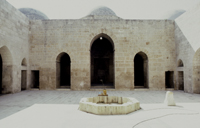
Figure 29. Prayer hall facade.
The portal opens into a long vestibule, an arrangement apparently adopted so as to provide an entry on the north side, facing the road, while leaving the interior of the north wing free for a large îwân-hall and flanking chambers. At the far end of the vestibule a doorway opens to the left, just before a recess provided for the doorkeeper. The doorway opens into a corridor that leads to the courtyard. The courtyard facades have been rebuilt so completely that it is hard to say what was intended originally; the northwest corner of the courtyard and the prayer hall facade are the only clues. The east and west courtyard facades as reconstructed are not very satisfying, and there must have been some better provision for cells on the second story; only a round window at the west end of the north facade gives any acknowledgement that there were rooms at this level. A thorough investigation of the plumbing of the building might indicate whether some of the smaller rooms were toilets.
The original pavement of the courtyard, now replaced, was the usual ablaq, and the octagonal basin in the center, with its cusped inner corners, is original. The same shape appears in other monuments of the period, and it is probably a habitual detail of the anonymous architect. The large and deep îwân-hall dominates the courtyard in the same way as that of the Madrasah al-Shâdhbakhtîyah.
The prayer hall, composed of a dome extended by barrel vaults, is opened up to the courtyard through a wide central entry, flanked by smaller doorways, like the prayer hall of the Madrasah al-Sultânîyah. One can still see where the wooden frames of the closures of these openings were let into the masonry. In the two south corners, two chambers with covered with domes on concave split pendentives extend the prayer hall the length of the south side.
The central dome rises from muqarnas squinches borne on concave dwarf split pendentives. The upper tier of muqarnas includes three-gored cells that develope the squinch into something like a gored semidome. Between the squinches the second tier is made into a blind arcade of muqarnas cell forms.
The mihrab is a rather small and plain example of stone inlay, built directly into the wall, cutting into the haunches of a pointed arch in the original masonry of the wall. Originally the cylinder of the niche was filled with marble openwork, but this has been broken away completely.
Notable aspects of this monument are the design of its portal vault, the accomplished handling of the antemihrab dome's zone of transition, and the arrangement of the plan so as to permit a large northern îwân-hall. The portal's muqarnas is so close to that of the Firdaus that I see them both as the work of the same architect; as he is unnamed in either inscriptions or historical sources, I am inclined to call him the Firdaus architect, after what appears to have been his most important commission.
The portal projects about 3 cm. from the exterior wall to its east; I have no reliable notes on the finish of the portal bay.
Course heights, piers in center prayer hall facade: partly buried, 44, then four courses of 47.5.
Within, the prayer hall masonry is medium toothed long stroke and medium toothed medium stroke; the mihrab is well finished with a smooth tool.
Although the Madrasah al-Sharafîyah was founded as a mosque before 601/1205, nearly all of the building belongs to a second campaign of construction that is probably two decades or more later. It was used variously before falling almost entirely into ruins; parts of it were rebuilt sometime following 1331/1912–13, apparently in the 1920's.33 It is currently in use as a library. Only some parts of the original Ayyûbid fabric remain: the portal, the prayer hall, and probably parts of the east wing.34
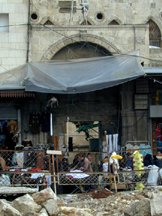
Figure 30. Madrasah al-Sharafîyah, portal.
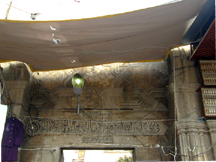
Figure 31. Madrasah al-Sharafîyah, portal, detail.
The Madrasah al-Sharafîyah is directly northeast of the northeast corner of the Great Mosque, its portal opening to the west onto the street that runs along the Great Mosque's east side. Before the Mongol invasion it may have been one of the most interesting and lavish of Aleppo's Ayyûbid madrasahs.
Ibn Shaddâd reports that the madrasah was founded by the shaykh and imâm Sharaf al-Dîn Abû Tâlib `Abd al-Rahmân b. Abû Sâlih `Abd al-Rahîm, known as Ibn al-`Ajamî, who spent over 400,000 dirhams on it and made handsome auqâf for it; his son, Muhî al-Dîn, taught there until he was killed at the sack of Aleppo by the Tatars in 658/1260. Ibn Shaddâd then adds that the Shaykh Sharaf al-Dîn, the donor of the waqf, died after the sack of Aleppo by the Tatars, in 658/1260, and was buried in a tomb (qubbah) he had founded north of the madrasah and in which he had decreed he should be interred. Both father and son died the same year.
Ibn al-Shihnah repeats the first part of Ibn Shaddâd's notice, omitting the remarks about the death and tomb of the founder, and naming the son Muhî al-Dîn Muhammad. Earlier, in describing the Khânaqâh of Shams al-Dîn b. al-`Ajamî, Ibn al-Shihnah remarks that Sharaf al-Dîn inherited from his brother Shams al-Dîn upon the latter's death, and, that “he,”, that is Shams al-Dîn, died in [6]31/1233–34.35 The genealogy of the Banu'l-`Ajamî, as untangled by Anne-Marie Eddé, confirms this reading of the sources.36 They were among the richest and most powerful families of religious scholars in Aleppo, beginning in the reign of Nûr al-Dîn and continuing through the Ayyûbid period.
A much longer description of the madrasah is given by the fifteenth century scion of the family, Sibt b. al-`Ajamî.37 Sibt b. al-`Ajamî's account evidently derives from family knowledge. He wrote:
The Madrasah al-Sharafîyah al-Shâfi`îyah. It was founded by the Shaykh and Imâm Sharaf al-Dîn Abû Tâlib `Abd al-Rahmân Ibn al-`Ajamî, God's mercy on him and his family. He spent on its construction over 400,000 dirhams, as Ibn Shaddâd says.
In its northern wing (shamâlîyah), until the invasion (fitnah) of Tîmûr, was a coffer (sunduq) of wood said by some of the family of its endower (wâqif) to have been used for the sake of tools [reading âlât] of construction, and said by others to have contained dirhams for buying food for the [construction] workers. His brother, Shaykh Shams al-Dîn, who was skilled in alchemy, provided to his brother [Sharaf al-Dîn] the money for it, as I have said s.v., al-Shamsîyah.38
This madrasah is large. Al-Dhahabî says about it “it is beautiful and handsome (hasanah, malîhah) and is the utmost in refinement and beauty of construction and workmanship (fî ghâyat al-irtifâ' wa husn al-binâ wa'l-san`ah).”
Its portal [reading bawwâbah] has no imitation in its fashion, its îwân-hall is unique in its class (îwâniha farada fî bâbah), its mihrabs are the utmost in nobility (mahâribihâ ghâyat fi'l-jûdah), the marble of its floor (ard) is solid, and its basin (birkah) is among the marvels of the [51v] world (min a`âjîb al-dunyâ), ten stones guided in their assembly as only masters can do (la yahatadâ ila tarkîbihâ ila al-hudhâq). Presently its depth is a fathom (qâmah), as also is its width. It is said that is was deeper than that and that people fell into it, but none of them died, thanks to the influence of its founder.
At the yellow stone at its north the Prophet was seen, praying. My father never sat on it to perform his ablutions, but stayed to its side.
At the time of its founder, water was conveyed [to this basin] from a water-raiser (dûlâb) opposite the main portal of the madrasah (bâb al-madrasah al-kabîr). The founder [also] built at [the madrasah] a conduit (sarab) for the madrasah's sewerage, which debouches outside the city and is not shared with anyone else except those responsible for this madrasah [?].
The latrine (tannûrah) was constructed (khasafat) outside the madrasah, north of it, and was roofed. In this tannûrah was a cistern (jibâb) in which night soil (al-qadhûrât) collected until it was discharged into the conduit. When it was constructed they took the wood of the northern wing (shamâlîyah) and roofed it with that material. My father said that it was constructed twice, because originally it had a vault (qabw).
Shaykh Yaqûb, the custodian (qayyim) of the madrasah, descended into this conduit [sardâb, sic] and saw that it was solid (muhkam); he followed it to the portal (bâb) of the Rawâhîyah before returning.
This madrasah [the Sharafîyah] is built of Hiraqlî stone39 and has a brilliant appearance (alayha nûrânîyah zâhirah); and its reflection rejoices and expands the heart and spirits (kayf).
The master (mu`allim) who built (binâ') it was al-`Abd al-Salâh, head of the brotherhood (shaykh al-tarîqah), Abû Bakr, the guidepost (al-nusbah),40 who is buried in the Maqâm al-Shaykh Fâris in Jabal Bâbillâ, and his name is written (maktûb) on (`alâ) its mihrab and the name of the stonemason (nahhât) is written on (`alâ) its portal (bâb). And his name is Abu'l-Thanâ' b. Yâqût.41
A band (tirâz) was made (sana`a) on (`alâ) its facade (hâ'itihâ al-`azîm) in which to inscribe whatever was desired, and the same on (`alâ) its îwân-hall, but this was not done, because its founder was carried off by death; it [the madrasah] was never completed, [although] construction on it spanned forty years; God's blessing on [the founder]. No one sits on the benches (dikak) that are outside the portal (bâb), out of respect for him; rather, they sit on the benches inside the portal and in its îwân-hall [?].
This madrasah has three stories (adwâr) of chambers (khalâwî) of solid construction; with doors and closets (al-abwâb wa'l-khazâ'in).
Above the îwân-hall and the storeroom (hâsil), now called “the cave” (al-maghârah), is an apartment (qâ`ah) reserved for the professor, and in this apartment is a door (bâb) from the îwân-hall and one from the courtyard [?—ard al-madrasah] At the back (sadr) of this îwân-hall is an air shaft (bâdhanj) in which were three openings (abwâb), until two of them were blocked for fear that an earthquake could damage the îwân-hall.
In this madrasah are two wells (bi'rân) and two reservoirs (sahrîjân). Over one of the wells is a frame (qantarah) of iron. Inscribed on it is an endowment (waqf): “The donor of this frame is the same as the founder of this madrasah, `Abd al-Rahmân b. `Abd al-Rahîm b. al-`Ajamî, for the benefit of the well (jubb), in Rabî` al-Awwal, 640/August–September 1242. The name of its maker (sâni`) is `Alî b. Abû Bakr b. Muslim.” On it is writing in Kûfic script (khatt bi'l-kûfî), which I could not read. This inscription is not engraved (hafran) but rather applied with a hollow pen [?—reading qalam al-mujawwaf]. On it is: “Jafar made it [sana`ahu Jafar, sic]” in marvelous writing (badî` al-rasm). This iron frame is the most amazing thing; if one witnesses it one wonders how it was made.
Alongside this madrasah is the tomb (turbah) of its founder, and he [52r] is buried in the middle of it, according to the endowment (waqf). The endowment was increased by his granddaughter, `Ā'isha.
On the side of the qiblah (qiblîyah) of it [the madrasah] is an old mosque (masjid qadîm), which the founder did not change except to restore ( `ammara) its wall (hâ'it), leaving the portal (bâb) of the mosque in its place and opening another in it, to the south wing (qiblîyah) of the madrasah—as I have been told.
I have read in its [the madrasah's] deed of endowment that the founder—he who built (binâ') it—endowed it as a mosque (masjid); to the side of this mosque was a chamber (bayt) that was a garage for carts that hauled stones during the construction of the madrasah. When the founder, God bless him, found that the carts that hauled stones impeded access to the building, he removed [the garage] from [the madrasah's] possessions and demolished it to open the street (tarîq).
In this madrasah the doors of the chambers are of wooden joinery of the most beautiful techniques (al-abwâb al-manjûrah `alâ khalâwî min ahsan al-sanâ'i`): inlay (al-muta`am), carving (al-hafr), openwork [?—khayt], and starwork [?—mukaukab], and others of the sort, which are the pride of the artisans (al-sunnâ`). Most of them have vanished, through want of upkeep.
In the aforementioned “cave” (al-maghârah) of this madrasah were colored marbles (al-rukhâm al-mulawwan) and colored tesserae (al-fusûs al-mulawwanah) in large quantity, with which the îwân-hall and its facade (hâ'it), along with its south wing (qiblîyah) and its facade, were to be revetted. But when the founder died, God bless him, his relations took it and divided it among themselves and carried it off to their houses (buyût).
The founder, God bless him, endowed this madrasah with precious books (al-kutub al-nafîsah) in all fields: traditions, exigesis, law, grammar, and others of the sort. Among these books are the Musnad of the Imâm al-Shâfi`î, his Umm, and all his books, God bless him; and the books of his followers, such as the Tafsîr of al-Tha`âlibî and other books on tafsîr: al-Nihâ'iyah, al-Hâwî al-kabîr, al-Ibânah, al-Tatimmah, al-Dakhâ'ir, and al-Shâmil. On hadîth there are the six books, among them all the books of the [al-Shâfi`î] school, lacking only the books of al-Râfi`î and al-Nawawî, as such books could no longer be obtained in Aleppo. In it were forty copies of al-Tanbîh and all the books of al-Ghazâlî. The titles of the books were kept by the relatives [of the founder] in a large scroll (darj) that disappeared during the invasion [reading fitnah] of Timur.42
I was told that it was a condition of the endowment [of the madrasah] to buy for the gates [abwâb, sic, but Sauvaget sensibly emends abwâb to îwân] of the madrasah mats (husur) from `Abâdân and carpets (busut) from Aqsaray.
[The founder's] relatives tell me that it was also stipulated that no one [i.e. no government official] should interfere with the superintendant (al-nâzir) in the running of the madrasah; if this should happen the door (bâb) of the madrasah should be closed and the endowment should revert as an endowment for [the founder's] family. I have [also] read this in the endowment deed (kitâb al-waqf).
The endowment was handsome, including such properties as al-Qurashîyah, on the road to Bâlis, and others of the sort. In it [the endowment deed] it was stipulated that two muezzins should perform the call to prayer from atop [the madrasah's] portal (bâb). Of the property endowed for the two muezzins is a part (hissah) of the village of Hirbîl, to which another, al-Tarsûsî, added a part of the village of Dîdahîn. [The endowment deed also states that] in [this madrasah] is a doorway (bâb) on the south side that opens into the chambers (buyût) of the secretary (khatîb) Hâshim. The son of [the founder], Muhî al-Dîn Muhammad taught there, and his name is written in the deed of endowment. [List of his successors] …
Ten professors succeeded him, each unmatched in the city in his age, until [52v] the Tatars invaded Aleppo; the founder died soon after, on 24 Safar 658/9 February 1260.43
Then almighty God revived this madrasah, and distinguished professors taught there until the invasion (fitnah) of Timur. Among those who taught after that was my father, the hâfiz Burhân al-Dîn.
While this account leaves much unsaid, given the fragmentary condition of the building it is very valuable evidence. Before commenting on its specifics and analyzing the remains I shall quote in its entirety Creswell's description of the building:44
The Madrasat ash-Sharafîya, at Aleppo, is in a somewhat fragmentary condition. There is a very fine stalactite entrance bay (A) in the west façade, at the back of which is a door opening into another bay (B), covered by a semi-dome facing in the opposite direction and forming the centre of the west façade of the sahn (C). To right and left are two arches springing from piers and resting on a central column (D and E). They are now walled up, but I conclude that they once formed a portico to students' cells. On the north side of the sahn are three arches (F) resting on piers; everything behind them has disappeared, but I conclude, on the analogy of the Zâhirîya, that they also formed a portico to students' cells. On the south is the triple-arched masjid (G), with a very beautiful stalactite dome in the centre and a length of vaulting to right and left. The triple-arched façade is entirely concealed by a modern façade (H) placed a short distance in front of it. No doubt this modern façade has taken the place of a triple-arched portico exactly corresponding with that on the north side of the sahn. This opinion is strengthened by the fact that the centre of the middle arch of the latter is in an exact line with the centre of the triple-arched façade of the masjid, and with the centre of the mihrâb. On the east side of the sahn can still be seen the pier of the arch of a great lîwân (K), buttressed by a smaller one (L) on the left, and once no doubt, on the right also. The rest of this façade has disappeared.
By now half of what Creswell saw has likewise vanished.
Sibt b. al-`Ajamî tells us that the madrasah was originally endowed as a mosque, and that the madrasah was unfinished at the death of the founder in 658/1260. His mention of material for revetment being kept in store indicates that it was the decoration that was incomplete. The building seems to have been complete structurally, as indeed it ought to have been after the expenditure of a fortune. While we do not know the actual cost of construction in Ayyûbid times, the remark that Shams al-Dîn was skilled in alchemy may be meant to stress—playfully?—that the cost was far beyond the usual.
While Sibt b. al-`Ajamî gives no date of foundation, the first architect he mentions, `Abd al-Salâh Abû Bakr, is known from his funerary inscription to have died in 601/1205; Sibt b. al-`Ajamî knew where he was buried and could have known this date. So the original foundation—at least by the Banu'l-`Ajamî—of a religious institution on this site was before 601/1205. At some point the institution was converted or expanded from a mosque to a madrasah.
Sibt b. al-`Ajamî's round number of “forty years” for the duration of construction may simply be an inference from the date of `Abd al-Salâh's death and the inscription he read on the water-lifting apparatus over the well, which gave him the date of 640/1242. The actual span of active construction may have been shorter.
An epithet of the architect `Abd al-Salâh Abû Bakr, al-nusbah, appears in an inscription on the building's mihrab,45 in a roundel above the niche. Presumably the rest of the name appeared elsewhere on the mihrab.
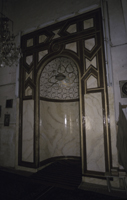
Figure 32. Mihrab.
`Abd al-Salâh, described by Sibt b. al-`Ajamî as Head of the Brotherhood (shaykh al-tarîqah), Abû Bakr the guidepost (al-nusbah), was evidently a Sûfî. The fragment of his funerary inscription (mentioning a turbah) at the Maqâm al-Shaykh Fâris, no longer in situ, calls him sultân al-tarîqah wa shaykh al-haqîqah Abû Bakr al-nusbah, al-Marâghî (of Marâghah, in Persian Azarbayjan) giving the date of death as Ramadân 601/May 1205.46 Herzfeld also reports the inscription recording the foundation of the present shrine building (calling it a mosque, masjid), in the name of Yûsuf b. al-Shaykh Abû Bakr al-nusbah, evidently a son and also a leader of whatever Sûfî group was connected with this site, as his (unspecified) works at the shrine demonstrate.47 What if anything this religious affiliation had to do with Abû Bakr's profession, and how recently his family had emigrated from Persia, do not emerge from our evidence; his Sûfism could have been coincidental to his building career; the family could have been long established in Aleppo.
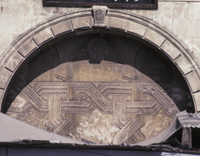
Figure 33. Madrasah al-Sharafîyah, portal, upper part.
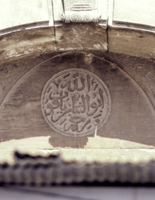
Figure 34. Portal, inscription.
On the portal it is Abu'l-Thanâ' b. Yâqût's name that appears, also in a roundel.48 A minimal conclusion from this evidence would be that the original part of the building, the mosque, was founded or restored (to fit with Sibt b. al-`Ajamî's account) by someone, probably Sharaf al-Dîn b. al-`Ajamî, and designed by `Abd al-Salâh Abû Bakr before his death in 601/1205, and that Abu'l-Thanâ' b. Yâqût at the least built and perhaps even designed the portal, possibly as late as 658/1260, but probably decades earlier.
In between these dates we know Sharaf al-Dîn to have been appointed coadministrator of the Madrasah al-Zâhirîyah (q.v.), in 610/1213–14.
A glance at Creswell's plan shows that the building is of two phases. The mosque was recessed behind an unnecessary vestibule, and while its facade was aligned with the tripartite arcade of the north wing, neither facade was aligned with the north-south axis of the courtyard and the basin, both of which were offset to the east. It appears that the mosque was designed with a much smaller courtyard, and that the plan was expanded later. The second phase involved the north, east, and west wings, including the portal. A new facade was built in advance of the prayer hall, probably matching the triple arcade of the new north wing's facade. Both these facades were arranged asymmetrically with respect to the north-south axis of the courtyard.
A stronger conclusion about the authorship of the madrasah, then, is that `Abd al-Salâh Abû Bakr designed a mosque, perhaps as part of a madrasah, but that the rest of the madrasah was not built before Abu'l-Thanâ' b. Yâqût redesigned the madrasah and completed its structure, including the portal. This still does not date the second phase of construction.
I assign the second campaign to a time soon after 631/1233–34, when the founder inherited vast wealth from his brother. On the basis of the inscription of 640/1242 on the iron well-head Sauvaget dated construction of the building in that year; Creswell allowed another decade (ca. 640–50/1242–1252). However, that inscription implies that the building's masonry was complete and that the courtyard was clear for use, nine years after the earliest probable date of refoundation. At this time the institution definitely became a madrasah; its scope was expanded and everything except what had been built already was redesigned by Abu'l-Thanâ' b. Yâqût. The well-head was signed by `Alî b. Abû Bakr, who could well have been a son of `Abd al-Salâh Abû Bakr, the original architect.
Sibt b. al-`Ajamî mentions inscription bands that were left blank because of the death of the founder, which I have argued often occurred when the waqf was made only at the founder's death. Confirming that this was the practice of the Banu'l-`Ajamî, Ibn al-Shihnah, in his notice of the Khânaqâh of Shams al-Dîn, states explicitly that the waqf for that institution was established after Shams al-Dîn's death, by his brother Sharaf al-Dîn. This endowment came from Sharaf al-Dîn's vast inheritance, probably at the same time Sharaf al-Dîn refounded the madrasah.
I attach no significance to Sibt b. al-`Ajamî's use of the contrasting terms mu`allim for `Abd al-Salâh Abû Bakr and nahhât for Abu'l-Thanâ' b. Yâqût, especially as Abu'l-Thanâ' b. Yâqût's inscription contains only his name and a pious phrase. I think instead that this is simply Sibt b. al-`Ajamî's attempt to attach meaning to the two names found in the building's inscriptions, which he surely read. It is nevertheless interesting that the meaning Sibt b. al-`Ajamî seems to have attached to them is that the former “built” the building (designed and oversaw construction?) and that the latter was a stonemason (executing the designs of the master?). This may have been a normal fifteenth-century division of labor, and in fact I argue below for something of the same sort in Damascus.49 Here, however, there seems clearly to be a sequence, with one architect taking the place of his deceased colleague, after a lapse of thirty years. The terseness of Abu'l-Thanâ' b. Yâqût's inscription and the remarkable masonry of the portal may have led Sibt b. al-`Ajamî to a false association of ideas.
Nothing of consequence save the portal remains of the street facade of the Madrasah al-Sharafîyah, yet its facade was rather long and tall. Sibt b. al-`Ajamî mentions inscription bands (tirâz) on the facade (hâ'itihâ al-`azîm), which I take to mean the street facade, and on the îwân-hall. None of these inscription bands is extant, but the street facade may have been arranged like that of the Madrasah al-Sâhibah in Damascus, of 630/1233, which has a cartouche band along the top, also blank, or the band may been set at the level of the frieze of interlaced grooved bands that crosses the portal.
Sibt b. al-`Ajamî says that the founder's tomb was alongside (ilâ jânab) the madrasah. Creswell's plan shows what looks like a tomb in the northeast corner of the structure, but the hatching of the plan shows that he thought it to be secondary, and as its piers block two original doors he was unquestionably correct. By analogy with other Ayyûbid madrasahs in Aleppo the tomb may very well have been to the west of the prayer hall, sharing the street facade of the madrasah. This may have been the property that had been a garage and was then bought out by the founder. According to Sibt b. al-`Ajamî, when the founder discovered that carts parked in a garage blocked the way, he removed this revenue-producing property from the endowment. He might have done so in order to demolish it without having to replace it with another revenue-producing building. As the garage must have been about at this spot, this unusual maneuver may indicate that the garage was demolished to make way for the tomb, which was then, singularly, built on private property.
The portal of the Sharafîyah had a remarkable muqarnas vault facing the street and a semidome on two rows of muqarnas facing the courtyard. The exterior of the portal stood ruined when Herzfeld's photograph of it was taken; it was later severely truncated. The interior vault, which is almost as different as possible, is still fully preserved, although the arcades flanking it have been hidden by encroachments into the courtyard, destroying its original context.
Creswell's photograph of the west side of the courtyard shows some rubble atop the portal block; in part this must have been remains of the parapet that was obviously missing from the top of the courtyard facades. It is not possible to determine the full height of the portal's exterior vault, but it may have extended above the cornice of the street facade. Indeed, the portal may have been crowned with some sort of platform, as the endowment stipulated that two muezzins should perform the call to prayer from atop the portal. (Had there been a minaret, Sibt b. al-`Ajamî would surely have mentioned it.)
The door frame of the portal was plain until 1331/1912–13, when two inscriptions were carved in its monolithic lintel. Above the lintel is a high frieze of geometrically interlaced grooved stone bands, in two patterns of grooving. Until the lateral walls of the portal were cut back, in the rebuilding campaign of the 1920's, this frieze extended across all three sides of the bay, although the interlace was not quite complete toward the bay's outer corners. The two sets of bands do not intertwine with themselves, only with each other, and it appears that there are some segments that do not form part of the interlace. Aside from the manner of their interlace, these bands may well have been colored in some fashion.
Another, truly instructive irregularity is that in the lateral sides of the bay the octagrams of the interlace are not centered under the hexagonal minor semidomes in the muqarnas above them, as they are on the back wall of the bay. This irregularity is really a divergence of geometries. The geometry of the interlace is derived from the proportions of the bay, which is about 3.4 meters wide by 2.1 meters deep, far from the 2:1 ratio common for muqarnas portals, and closer to 3:2. The interlace was set up in the proportion of 3:2, with three octagrams on the back wall and (almost) two on the lateral walls. However, the hexagonal semidomes of the muqarnas are of necessity longer from point to opposite point than they are from side to opposite side. In this case their long dimension runs in the depth of the vault, so the hexagons are longer in the depth of the vault than across its width. As a result, the lower tier of muqarnas is three cells wide and only one and a half cells deep.
Toward the top of the center back cell is the roundel bears the signature of the architect, Abu'l-Thanâ' b. Yâqût. It might better have been placed in the center of the cell, but this tier is formed of two courses, splitting the more desirable location. This division in courses was taken advantage of to simplify the brackets, which start only in the upper course.
The three arches of the three back cells adjoin the brackets with a shallow raised strip that outlines wide scalloped ogival tabs between the arches, on which the brackets are continued in an equally shallow plane, doubling the scalloped outline.
The second tier of muqarnas cells and the strongly projecting corbels that divide them formed the back halves of the hexagons. The shallow triple vault of the portal to the palace at Sahyûn, though it is in a different geometry, is similar in approach and is also set immediately above an interlace of grooved stone bands.50
Herzfeld's reconstruction drawing of the Sharafîyah portal shows this lowest tier of muqarnas as extending, complete, to the outer corners of the bay. This is unfortunately only speculation; also speculation is the large ribbed semidome Herzfeld supplied in his drawing. The outermost stones were evidently missing from the second tier even in Herzfeld's day, and there is no guarantee that the muqarnas treatment extended fully to the outer corners. Another strong possibility, seen in the vault of the Madrasah al-Kâmilîyah, is that there was a frontal arch about 40 cm. deep, changing the proportions of the vault behind to 2:1 and reducing the size of the ribbed semidome.
In terms of the “Muqarnas Questionnaire” in Appendix A, this vault is half as deep as it is wide, it springs from corner and presumably side brackets; there is no cornice, but it springs immediately above the interlace; the back corners need no special handling because of the brackets; there were three tiers of muqarnas and one of ribbed dome; the cells decreased in height from bottom to top and their depth was proportional to their height, varied by the side of the hexagon involved; there were three sets of hexagonal axes, and the sexpartite geometry was maintained throughout; there were neither rolled square brackets nor branched brackets; the strongly projecting corbels needed no branches in this geometry; there could have been gored conches, in the third tier, but there is no evidence either way; the corners are not developed into domelets, but one might well say that there were three “flues” here; the top of the vault was a gored semidome rather than a smooth semidome decorated with geometric ornament, I believe, but this cannot be shown; it is impossible to know whether the exterior arch profile reflected the profile of the muqarnas; and it is unknown whether there was a decorative archivolt.
The interior of the portal is a slightly pointed semidome on two tiers of muqarnas, set directly on top of the door opening, there being no lintel proper. The courtyard side of its frontal arch was distinguished from the arches of the neighboring arcades by a sunken but still projecting half-round fillet, springing from segments that turn outward and stop.
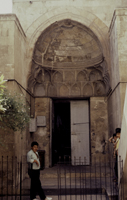
Figure 35. Portal, east side.
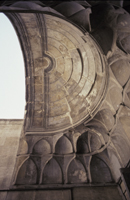
Figure 36. Portal, east side, vault from below.
The frontal arch and the semidome behind it cap two tiers of muqarnas that extend to the frontal plane of the bay. The semidome and frontal arch are entirely framed as a set and individually outlined by multiple thin moldings. The frontal arch is extended in a small semicircle to include the keystone. The interior of the semidome is composed of concentric courses of long stones, bevelled horizontally. The two tiers of muqarnas are cleverly deformed to fit the base of the semidome; while they are otherwise quite plain, they seem quite similar to the muqarnas cells of the exterior of the portal.
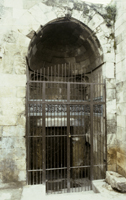
Figure 37. Madrasah al-Karîmîyah, portal.
The same general combination of elements—a semidome resting on muqarnas—occurs in the earlier Mashhad al-Muhassin portal and in the later portal of the Madrasah al-Karîmîyah, on a much reduced scale. In the latter, even the coursing of the semidome is similar to that of the Sharafîyah. While this could be a case of imitation, it is significant that the inscription on the Karîmîyah's portal, dated 654/1256, attributes the restoration of the building to al-Malik al-Nâsir [II] Salâh al-Dîn, under the supervision (bi-tawallî) of `Abd al-Rahîm b. al-`Ajamî. Herzfeld identified the building as the house of Shams al-Dîn, endowed as a khânaqâh by Sharaf al-Dîn in 631/1233–34, and decided that `Abd al-Rahîm b. al-`Ajamî must have been the son of Sharaf al-Dîn. Whatever the genealogy of the family, the coincidence of patronage and motif point to the Karîmîyah as another work of Abu'l-Thanâ' b. Yâqût.
The contrast between the exceedingly angular and deeply folded muqarnas of the exterior side of the portal and the ostentatiously round interior side is as strong as the contrast between the planar interlace of the exterior and the Ornamented Style moldings and bevelling of the interior, or between the height of the exterior's door frame and the interior's lack of any lintel. Only a hint of the Ornamented Style shows through on the exterior, in the frilly tabs of the lowest tier of brackets. Neither side of the portal much resembles any prototype. The interlace is conceptually an extension of the knotted interlace of the portal of the Mashhad al-Husayn, of 592/1195–96, and the deeply developed muqarnas is reminscent of the deep portal bay of the Mashhad al-Husayn, too, but otherwise the novelties of both sides of the portal are original.
Possibly the visitor was intended to perceive the two sides of the portal in contrast, but it is no less likely that the semidome of the interior vault was intended to correspond to something in the interior, and that Abu'l-Thanâ' b. Yâqût simply created divergent compositions. In any event, both are deliberate departures from the local style, not in details but in overall conception.
Creswell's photographs show clearly that the portal shares the coursing of the piers of the arcades to either side, while not in bond with them. The whole western side of the madrasah must therefore be of the same period, portal included, and it is reasonable to suppose that the northern and eastern wings were part of the same campaign as well.
These arcades may be understood better by comparing them to those of the Madrasah al-Kâmilîyah al-`Adimîyah. In that building, much shorter columns support capitals from which pointed arches spring immediately. Behind the arches the arcade is one story in height, and the second story rises flush with the arches. By contrast, in the Sharafîyah, the columns rose two stories, supporting columns, muqarnas capitals, and rather high imposts, from which the arches sprang. The zone between the capitals and the tops of the arches was the third story. For the length of the west wing all three stories were set back behind the high arcade, an impressive but rather wasteful use of space.
The arcade of the north wing continued the rhythm of the arches of the west arcade, at a slightly reduced scale and without the columns. Creswell's plan and photographs show that the three arches in the courtyard facade of the north wing were as tall as the îwân-hall, but rested on piers less than a meter wide, which cannot have represented the ends of north-south walls. Thus there were no chambers immediately behind these arches: they were only an arcade, screening a block of rooms that occupied two-thirds the depth of the space available. Somewhere, probably in the arcade, stood the wooden coffer remarked by Sibt b. al-`Ajamî, but otherwise this wing is of uncertain purpose. There is no surviving evidence for the access to upper floors here or elsewhere in the building (although stairways might have existed adjacent to the portal, for the muezzins). The chambers in this wing might have been cells or public rooms. Both the arcade and the ground floor of the block of rooms behind it had entries to the large square area at the northeast corner of the building, which would have been a suitable area for the institution's kitchen or bath, if it had one, or both.
The latrine was beyond the north wing, to the north. Sibt b. al-`Ajamî's remarks about the latrine suggest that the building was partly derelict in his day, as wood taken from the north wing for reroofing the latrine is likely to have come from something essential (perhaps even its roof). The site of the water-raiser, across from the portal, is presently a parking lot. If a head of water was maintained there, some elevated conduit across the street to the madrasah must have existed. The sewer Sibt b. al-`Ajamî describes was probably an Antique work that was reëxploited. The Madrasah al-Rawâhîyah, toward which the sewer ran, has not been located, but was close by, apparently to the west.51
Although there are two large round-headed barrel vaulted bays to the east of the courtyard, the southern one may be mostly reconstruction, and both are almost entirely obscured by the Ottoman facade that has been applied against them. For firm knowledge, we must rely largely on Creswell's plan, which shows an îwân-hall flanked on the north by a chamber of the same size (where a tall building now stands), with a large opening on the courtyard. Creswell inferred a similar room south of the îwân-hall.
To judge from Sibt b. al-`Ajamî's remarks, the facades of the îwân-hall and the mosque were to be revetted with marble, perhaps in the manner of the Mashhad al-Husayn; the mosaic he mentions must have been meant for an interior, probably along with with marble panelling, a common combination later in the century. This would have been a early use of mosaic; for more on that topic, see Chapter Ten.
The îwân-hall mentioned by Sibt b. al-`Ajamî is the îwân-hall shown in the middle of the original east wing on Creswell's plan. The “cave” mentioned by Sibt b. al-`Ajamî is one of the chambers to its north or south, although surely neither chamber was intended as a storeroom when it was built: such spaces generally were meant for lectures or receptions or other functions of the institution. The professor's apartment was located at the top of the east wing, away from the students's chambers in the west wing, and is apparently lost. From the number of books mentioned by Sibt b. al-`Ajamî, there should have been a library, and this could have been in whichever chamber was not the “cave.”
Sibt b. al-`Ajamî describes a blank inscription band (tirâz) on the îwân-hall; this may have run along the top of its facade. Even in Creswell's day the entire courtyard had lost all masonry above its arches, including, on the east side, the courses that might have borne this inscription.
The original prayer hall was only one bay deep. The present narthex or second row of bays, as one chooses to understand it, must duplicate the arrangement adopted for the second campaign, but it is recent, after the building campaign of the 1920's.
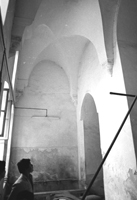
Figure 38. Prayer hall, narthex.
The original facade of the mosque had a large central opening in the form of a pointed arch and two smaller openings to either side, also pointed arches.
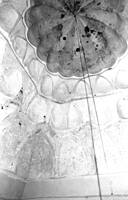
Figure 39. Prayer hall vault.
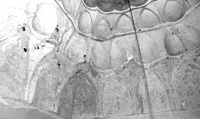
Figure 40. Prayer hall vault, detail.
The tall central bay of the prayer hall is covered by a muqarnas vault built either of plaster or of stone covered with a thick coating of plaster. The present exterior is a tall octagon of stone with a small dome in the center. Inside, three tiers of muqarnas suppor a sixteen-gored dome. The lowest tier is much taller than the second tier, which in turn is somewhat taller than the third tier. In the lowest tier I noted while restoration was under way in 1983 a geometric pattern of small holes drilled into the plaster and connected by incised lines, implying some decoration in relief. This vault is unlike contemporary muqarnas vaults in Aleppo and is reminscent of the sugarloaf muqarnas over the tomb of Nûr al-Dîn in its proportions and in that its sides are squared: most of the transition from square to round is in the uppermost tier. It may have been intended to recall some particular sugarloaf prototype.52
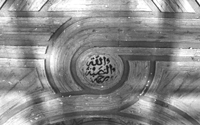
Figure 41. Mihrab, detail.
The stone mihrab is painted, but its joints are clear. It is a stilted semicylinder with a round niche head filled with an incised polygonal star pattern in two fields: a thick surround and a central lunette. The niche head, the semicylinder, and the side panels are outlined and divided by a molding of multiple fillets in a way similar to the outlining of the interior vault of the building's portal. The surround of the mihrab is contained within a moderately plastic border that surrounds the entire mihrab, cutting across the base and looping back along the bottom of the niche.
Whether the mihrab belongs to the first or second campaign of construction is not quite clear: the name of `Abd al-Salâh Abû Bakr is missing: only his epithet, al-nusbah, appears in the roundel above the niche, so perhaps the mihrab was reconstructed somehow in the second campaign.
I have suggested that the founder's tomb lay west of the prayer hall, between it and the street. What lay in the portion of the south wing east of the prayer hall, on the other side from the tomb, is impossible to say. This quadrant of the building had a doorway to the courtyard but not to the prayer hall. Sibt b. al-`Ajamî mentions a door from the south wing to the “chambers of the secretary Hâshim,” which must have been here; a small courtyard, with or without rooms ranged around the center, could have occupied the area.
The general plan of the courtyard, with arcades at north and south ends, appears to be derived from the Madrasah al-Zâhirîyah, with which the Sharafîyah's founder was connected. But the most remarkable thing about the courtyard must have been the dissimilarity of the facades arrayed around it. One was an arcade on columns split symmetrically by a vaulted portal; another an arcade on piers; another a trio of huge vaults, intended to be revetted with marble; and the last an asymmetrical small-scale affair, also intended to be revetted with marble. No other madrasah of the period combined such an ambitious design with such a motley composition.
The basin, so praised by Sibt b. al-`Ajamî, is now lost; from Creswell's photographs, it was of a type common in the period; I do not see that it was remarkable.
Sibt b. al-`Ajamî says “the doors of the chambers are of wooden joinery of the most beautiful techniques,” mentioning inlay (al-muta`am), carving (al-hafr), openwork (?—khayt), strapwork (?—mukaukab), and “others of the sort, which are the pride of the artisans (al-sunnâ`).” This is a rare catalogue of techniques, especially valuable for an age that excelled in woodwork, although Sibt b. al-`Ajamî's terminology may not be the same as that of the mid-thirteenth century. These lavish appointments are in keeping with the ambitious proportions and marble and mosaic revetment of the building.
Sibt b. al-`Ajamî says that he was told that it was a condition of the endowment of the madrasah to buy for the gates (perhaps îwân-hall) of the madrasah mats (husur) from `Abâdân and carpets (busut) from Aqsaray. This is a welcome indication of what varieties of these goods were most valued in Ayyûbid—or Mamlûk—Aleppo, which had good trade connections with both `Abâdân and Aqsaray.
The exteriors of the jambs are finished extra fine. The interlace is extra fine and the octagrams are smooth faced. All lower stones on east side of portal are restorations. The muqarnas is extra fine, as is the round vault. The prayer hall facade, where original, at east of the eastern (late) window, is mostly medium toothed long stroke; in some places coarsely toothed medium to long stroke and finely toothed medium stroke finish is to be found combined on same stones.
The Madrasah al-Firdaus, located about 150 meters to the southwest of the Madrasah al-Zâhirîyah, generally between the Maqâmât and Sâlihîn cemeteries, is the largest and best known of the Ayyûbid madrasahs of Aleppo.53
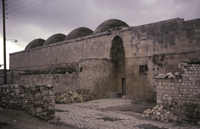
Figure 42. Madrasah al-Firdaus, general view.
While at first it may seem an unadventurous example of the Plain Style, the ensemble of familiar parts, from the muqarnas portal to the courtyard, enclosed on three sides by arcades and dominated by a grand îwân-hall on the other, is the most mature and balanced in Aleppo, and there are many special touches. I first saw the Firdaus on a rainy day. The rain made the stone pavement of the courtyard glossy and deeper in color than that of the dry îwân-hall and arcades, while the raindrops splashed into the water of the reservoir. There may be no better view in the Ayyûbid architecture of Aleppo than that from the courtyard îwân-hall of the Firdaus when it is raining.
The Firdaus has two principal inscriptions, one along the east exterior, the other running along the arcades and the interior of the courtyard îwân-hall.
The principal exterior inscription is carved in relief in a recessed band about half a meter high that begins about ten meters north of the portal, runs horizontally through the portal bay, one course below the muqarnas vault, and continues down the length of the east exterior wall, overrunning its allotted space and concluding in two smaller lines over one of the windows south of the portal. It begins with Qur'ân 43:68–72, which extends through the portal bay and says,
O my servants, today no fear is on you, neither do you sorrow, even those who believed in our signs and had surrendered themselves [become Muslims]. Enter [northeast corner of portal bay] Paradise, you and your wives, walking with joy. There shall be passed around them platters of gold, and cups, therein being whatever the souls desire, and the eyes delight in. Therein you shall dwell forever. This is the Paradise (jannah) that you have been given for an inheritance.54
Thus is introduced the theme of Paradise (though the word used is jannah, not firdaus) as well as what may be seen as a promise to maintain the inhabitants. The second part of the inscription then states, with much flourish of titulature, that the building (not further described) was founded by `Ismat al-Dunya wa'l-Dîn, Dayfah Khâtûn bint al-Malik al-`Ādil, widow of al-Malik al-Zâhir, during the reign of al-Malik al-Nâsir in the year 633/1235–36.
The conclusion of the inscription, in two lines, was first reported by Creswell: “a short inscription, hitherto unpublished, on the exterior, over a window on the east side of the building, which looks into the courtyard of a group of houses, built against the southern half of [the eastern] facade”. Rana Jalabi-Holdijk provides a photograph of this portion of the inscription, which is aligned beneath the name of al-Malik al-Nâsir about halfway through the historical part of the inscription.55
This is the very Dayfa Khâtûn who was born in the Citadel during the reign of her father al-Malik al-`Ādil in 581 or 582/1185–86, who was married to al-Malik al-Zâhir in her late twenties to provide him with an heir and ease the tension between him and her father, and whose wedding feast in the Citadel in 609/1212 had been disrupted by the disastrous fire. The inscription says that the building was founded in the reign of al-Malik al-Nâsir [II] Salâh al-Dunya wa'l-Dîn Yûsûf b. al-Malik al-`Azîz b. al-Malik al-Zâhir. Al-Malik al-`Azîz ruled from 613 to 634 (1216 to 1236), and was succeeded by this son, Dayfah Khâtûn's grandson, born in 627/1230; al-Malik al-Nâsir then ruled in Aleppo until the Mongol conquest. As al-Malik al-Nâsir was only a boy when he took the throne in 634/1236, Dayfah Khâtûn was named regent; she died six years later, in 640/1242, still in control.56
There is thus a discrepancy between the date given in the inscription and its account of who was in power. As the inscription refers to Dayfah Khâtûn as to one alive, and as it was probably one of the last pieces of construction to be executed, it is very likely that the building was completed before Dayfah Khâtûn's death in 640, giving us the range 633–40/1235–42 for the building's construction. It is not strictly possible to harmonize the date with the mention of al-Malik al-Nâsir, but perhaps the first documents in support of the institution were drawn up in 633, while the inscription was not composed until later; on this theory the discrepancy would simply have gone unnoticed. A more elegant but fundamentally more unsettling solution would be that the date is simply incorrect.
The interior inscription, partly described by Herzfeld, runs the length of all three arcades just below the level of the columns of the arcade, and around the îwân-hall on the north side of the courtyard.57 It is neither so tall nor cut in such deep relief as the exterior inscription. This interior inscription has never been published completely, and I have not studied it in situ, but its two parts are clear. It begins at the south end of the east arcade and concludes at the east end of the south arcade. The section under east arcade, which has been published, proclaims that Dayfa Khâtûn founded the building during the reign of al-Malik al-Nâsir; the second part matches a long text in prose and verse, praising the practice of prayer throughout the night as a means of reaching the presence of Allâh, included by Sibt b. al-`Ajamî in his notice of the building and translated by Sauvaget (but omitted in the passage retranslated below). There seems to be no date. While this inscription adds no historical information to the exterior inscription, it provides a strong indication of the religious motives behind the institution's foundation, as described by the historians.
Ibn Shaddâd wrote of the Firdaus:
The royal lady Dayfah Khâtûn bint al-Malik al-`Ādil Sayf al-Dîn Abû Bakr Muhammad b. Ayyûb founded it, and it is splendid and vast. She established here a tomb (turbah), a madrasah, and a ribât, and appointed to it people from the [ranks of the] Qur'ân readers, jurists, and Sûfîs. The first to teach in it was Shams al-Dîn Ahmad b. al-Zubayr al-Khâbûrî, who occupies it still in our day, that is, the year 673/1274–75.
Ibn al-Shihnah follows Ibn Shaddâd, omitting mention of al-Khâbûrî. Sibt b. al-`Ajamî, by contrast, devotes a quite lengthy entry to the Firdaus, which makes it clear that the building was large, complex, and surrounded by ample grounds.
The Madrasah al-Firdaus was founded by the lady Dayfah Khâtûn [as] a tomb (turbah), madrasah, and ribât, and she appointed to it people from the [ranks of the] Qur'ân readers, jurists, and Sûfîs. The first to teach in it was Shams al-Dîn Ahmad b. al-Zubayr al-Khâbûrî, who occupies it still in our day, that is, the year 673/1274–75, says Ibn Shaddâd. She gave to it an endowment, the village of Kafr Zaytâ and a third of its mill, of which another third is endowed to the Bulduqîyah.
The madrasah's construction is grand and lofty, of hiraqlîyah stone, brought from many places. In it is a dome for water (khashkhâshah li'l-mâ'î58) and a reservoir (birkah) watered from the garden (bustân) by means of a water-raiser (dûlâb) outside, and on one side of this garden is a grand îwân made of large ashlars. Inside this madrasah are yellow marble columns (`awâmîd min rukhâm al-asfar), and its mihrab is among the wonders of the world: he who looks at it sees his own face, on account of its polish.
In this madrasah a minbar was installed after [the days of] its founder, which is used on Friday. Before the invasion of Tîmûr, the sayyid `Alî al-Hâshimî said the khutbah from it, and also related hadîth there.
This madrasah is paved (murakhkhamâh) with white and black marble (rukhâm), and in it is a grand apartment (qâ`ah) for its professor. This madrasah has in its four sides outlooks and grilled windows (manâzar wa shabâbak) overlooking its garden (bustân). The building was formerly higher than it is now; it has been shortened. In it is a great portal îwân-hall (îwân), upon which is written, both in its inscription band (tirâz), and its [the building's?] inscription band: [There follows a long passage, including verse, praising the practice of prayer throughout the night as a means of reaching the presence of Allâh. Omitted here; see trans., pp. 80–82 and notes p. 82.] …
[f. 55r, l. 15] Inscribed upon the portal (bâb) is a band (satr)—and it [the portal] is the height of elegance, and is glorified by this band—[which says]
Dayfa Khâtûn ordered the founding of it in the days of the Sultân al-Malik al-Nâsir Salâh al-Dîn Yûsuf b. al-Malik al-`Azîz Muhammad b. al-Sultân al-Zâhir Ghâzî, under the supervision (bi-tawallî) of `Abd al-Muhassin al-`Azîzî al-Nâsirî, in the year 633/1235–36.
Thus did she memorialize him [al-Malik al-Zâhir] and al-`Azîz. It [the madrasah] was begun when he [al-Malik al-`Azîz] died and his son al-Nâsir came to power (sic). He who beholds what is here is surrounded by writings (masâhaf) of gold, and it is said:
On the gate of the Firdaus of Aleppo
is an astonishing band of pearls.
In it are pools (sihâf) of gold;
they are records (sahâf) of those departed.
There follow several anecdotes relating to the later history of the Firdaus in which the institution is called by that name. Sibt b. al-`Ajamî then provides this biography of Dayfa Khâtûn (f. 55v, l. 19):
Dayfa Khâtûn was the daughter of al-Malik al-`Ādil. In the year 608/1211–12 al-Zâhir Ghâzî sent the qâdî Baha' al-Dîn ibn Shaddâd to her father al-`Ādil in Damascus to press his suit, and asked for the hand of his daughter Dayfa Khâtûn, and he married them, extinguishing [the division] that had existed between the two [men]. Earlier, in 582/1186, he [al-Malik al-Zâhir] entered Aleppo [taking it over from al-Malik al-`Ādil as agreed with Salâh al-Dîn], and his [al-Malik al-Zâhir's] father [Salâh al-Dîn] married him to Ghâzîyah, daughter of al-`Ādil. So began a division of the kings; there was no harmony between them until the tying of the knot with Dayfa Khâtûn in Muharram 609/1212. The bride-price was five thousand dinars, which was sent [along with the bride, presumably] from Damascus in Muharram. Al-Zâhir received her with honor and sent to her handsome presents. In the year 610/1214 al-Malik al-`Azîz Muhammad was born to al-Zâhir by Dayfa Khâtûn. In 640/1242, during Friday night, eleven nights remaining in Jumâdâ al-Aulâ, Dayfa Khâtûn died from an abdominal ulcer (?—qarhah fî marâqq al-batn). She was buried in the Citadel of Aleppo.
She was born in 581 or 582/1185–87 in the Citadel of Aleppo when it belonged to her father al-`Ādil, before it was taken from him by his brother, the Sultan Salâh al-Dîn, and awarded to his son Ghâzî. Al-Dhahhabî says that she was born in [f. 56r] 581. She dispersed [bounty] to the poor and the learned (al-fuqarâ' wa'l-`ulamâ') and gave them considerable alms. All who praised her did so sincerely.59
When she died they closed the gates of the city (abwâb al-madînah) for three days while proclaiming al-Nâsir [II] Salâh al-Dîn ruler in his own right. When she was born her father was host to a guest (dayf); thus she was called Dayfa. She lived for close to 59 years.
Previously, al-Zahir had married her sister Ghâzîyah. She ruled Aleppo after the death of her son al-`Azîz as regent, dealing with kings and sultans. She ruled for close to six years, and after she died her son al-Malik al-Nâsir Yûsûf b. al-`Azîz lived almost thirteen years.
There follows a section dealing with the accession of al-Malik al-Nâsir and an account of the festivities at the birth of al-Malik al-`Azîz in 610/1214.60 The boy was al-Malik al-Zâhir's first legitimate heir, and the production of such a heir, descended from both Salâh al-Dîn and his brother al-Malik al-`Ādil, was the point of al-Malik al-Zâhir's marriages both to Ghâzîyah Khâtûn and then to Dayfa Khâtûn. Dayfa Khâtûn was in these terms a prompt success (for Ghâzîyah Khâtûn see Chapter Five, “The Works of Al-Malik al-Zâhir”).
As so often happens, the funerary purpose of the tomb chambers must be deduced from a patchwork of evidence.
According to Ibn al-`Adîm, in 639/1241 al-Malik al-Hâfiz Arslân Shâh b. al-Malik al-`Ādil died in the citadel of `Azâz; his catafalque was taken to Aleppo, where al-Malik al-Nâsir and notables of the city came out to meet it; he was then buried in “al-Firdaus” in the place prepared for him by his sister al-Malikah al-Khâtûn.61
I know of no other dated burials at the Firdaus.62
In 634/1237 Dayfa Khâtûn had buried her son al-Malik al-`Azîz in the Citadel, possibly as a temporary resting place, as Ibn al-`Adîm says that she was buried “in the enclosure (hujrah) in the Citadel that faces the suffah, in which her son al-Malik al-`Azîz was buried.”63
Yet the Firdaus was sufficiently complete that her brother could be buried there five years later. Conceivably she just never got around to moving al-Malik al-`Azîz, but I suspect that Sibt b. al-`Ajamî was guessing when he suggested that Dayfa Khâtûn built the monument in honor of al-Malik al-Zâhir and al-Malik al-`Azîz. In fact, it was a family tomb for those of her relatives who did not accede to the sultanate, like the Damascene tombs founded by Ayyûbid women that I discussed in Chapter One.
Perhaps even more importantly, the Firdaus was part of a lifelong program of pious works, of which the Khânaqâh of Dayfa Khâtûn (Khânaqâh fi'l-Farâfrâ) is another example. Ibn Shaddâd says, “She established here a tomb (turbah), a madrasah, and a ribât, and she appointed to it people from the [ranks of the] Qur'ân readers, jurists, and Sûfîs.” The Qur'ân readers go with the tomb, the jurists with the madrasah, and the Sûfîs with the ribât. The exterior inscription is addressed to these worthies: “This is the Paradise that you have been given for an inheritance.” While both madrasah and ribât are suitable to adjoin a tomb, they comprehend rather different modes of devotion, and the inscription in the courtyard îwân-hall emphasizes devotion strongly. This institution was founded as a center of piety, covering all the branches of religious knowledge. Not only was the tomb, with its Qur'ân readers, associated with a madrasah in the usual fashion, but a corps of Sûfîs was housed there as well. There would have been plenty of personnel here to pray throughout the night every night in the great îwân-hall.
It may be that Dayfa Khâtûn conceived the Firdaus as a multipart institution, like the grand foundations of later centuries, especially in the Persian-speaking world, which routinely combined madrasah, khânaqâh, tomb, and mosque. I know of no earlier examples of such combinations in Syria, although throughout the sixth/twelfth century many monarchs, notably Nûr al-Dîn, founded various religious institutions severally and in different locations. Nor do I know of any examples so early from the Persian-speaking world, though I do not doubt that there is a common prototype for all such multipart foundations.
That prototype may well have been the slightly earlier Madrasah al-Mustansirîyah in Baghdad, which housed the four schools of law along with a dâr al-qur'ân, dâr al-hadîth, hospital, dâr al-kuttâb, and regular lectures on other subjects including âdâb, the latter perhaps an accretion not planned for.64 By combining much of his patronage of education in one institution, al-Mustansîr gained greater visibility for it. Whether or not he was the first to do so, the result was a foundation tempting imitation.
Sibt b. al-`Ajamî touches on the Solomonic theme of building materials brought from many places. He must have had in mind the mihrab and the spolia deployed around the courtyard: while he does not mention the capitals, which catch the modern eye, he remarks on the “yellow columns” they cap. Aside from the pavement, the stone is all from the same quarry except for the courtyard's pavement and basin, which are entirely usual for the period (the pavement being limestone and basalt, not marble as Sibt b. al-`Ajamî says).
Sibt b. al-`Ajamî says that the madrasah “has in its four sides outlooks and grilled windows overlooking its gardens,” and that it had been shortened; thus the original outlooks must have been quite lofty. The structures at the north corners of the building represent these outlooks, and the view of the gardens from the other sides of the building was obtained through the many grilled windows. The implication is that the building was entirely surrounded by its grounds; it would then have required an exterior enclosure wall and gate. The open access to the north and west sides of the building indicates clearly that these sides were bordered by the building's grounds.
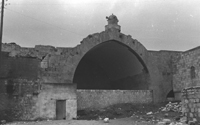
Figure 43. North exterior, view to south.
The intended principal exterior view is of the east side, with its long inscription. While this sort of facade is frequently found directly on a street, the structure at the northeast corner of the building, not to mention other clearly parasitic structures, would have blocked a street running directly along this facade. A plan published by Muhammad Mutlaq and taken from a cadastral survey, which shows these structures, permits the conclusion that the enclosure wall ran close to the east side of the building, so that a good view of the east facade was in fact available.65
To the north, an îwân-hall and two hallways were completely open to the grounds, unless there was an large outer courtyard there. Somewhere there must have been more housing than is preserved now; cells could have been built along the sides of such an outer courtyard.
Otherwise, we know only that the grounds were planted (because they are described as a garden) and possessed some manner of water lifter (dûlâb), connected somehow to a domed well-head (khashkhâshah). Provision of water by such mechanical means is also specifically noted for the Citadel and the luxurious Madrasah al-Sharafîyah, suggesting that it was considered something special, perhaps because it allowed a head of pressure to be maintained and thus supplied not simply water but running water.
The view of the madrasah from the road leading from the Bâb al-Maqâm to the Jisr al-Hâjj was thus of the back of the building, looming above the trees of its garden and surrounded by a high wall. A branch of that road led due south past the Firdaus's east side.
Aside from its inscription band, fairly new in Syrian architecture, the exterior is quite plain. The portal is the only other point of interest, and even it is hardly innovative. The muqarnas, which is imposing, is nevertheless restrained, without carved decoration or even fluted cells.
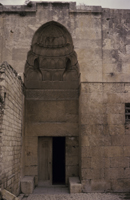
Figure 44. Portal.
The portal bay is almost entirely plain, built of regular courses and lined with two benches. Above a plain monolithic lintel is a relieving arch of three plain slipping voussoirs, completely rectangular on the exterior, topped by the recessed inscription band, another short course of masonry, and the muqarnas vault.
The arrangement of the long inscription in a single band, called by Sibt b. al-`Ajamî tirâz, in connection with the Madrasah al-Sharafîyah and satr here, had appeared in Aleppan architecture some years earlier, in the tomb known as that of Shaykh Sâlih, not far away, built in 621/1224 by an unnamed wife of al-Malik al-Nâsir Salâh al-Dîn b. Ayyûb, mother of al-Malik al-Afdal `Alî, possibly next to a preëxisting tomb, at the end of her life.66 There the inscription appeared high up on two exterior walls, turning the corner between them.
Sibt b. al-`Ajamî seems to say quite clearly that the inscription band was gilded, and the poetry he quotes sustains that suggestion. In favor of this view is the fact that the similarly placed inscription band on the portal of the Madrasah al-Zâhirîyah in Damascus was gilded, as was the band on the facade of the complex of Qala'un in Cairo.67 It may be only coincidence that the part of the inscription within the portal bay includes the words “platters of gold.” However, on the right side of the portal bay the background of the inscription shows considerable traces of blue paint, which would go well with gilt letters. While the paint may not represent the original treatment, and Sibt b. al-`Ajamî may be speaking figuratively, we must be prepared to imagine a more colorful exterior than can be seen today, with the full length of the inscriptions fully painted. Jalabi-Holdijk reports traces of blue and white paint on the interior inscription; again, these may not be original, but we must be prepared to imagine something of the sort.
In terms of the “Muqarnas Questionnaire” in Appendix A, this muqarnas is more than twice as deep as it is wide, due to the existence of a frontal arch. The actual dimensions are approximately in the proportion 4:7. It springs square from the back of the bay, without a cornice. Small domelets in the back corners are supported on three brackets each. The tiers decrease in height and depth as they rise. From beneath, the geometry is smoothly developed on an octagonal plan. There are no “flues” or rolled square brackets, but there are branched brackets in the lowest tier. At the top of the muqarnas is a gored conch, and the frontal arch follows the profile of the muqarnas only in its lower two tiers, so that the conch does not entirely fill the top of the arch, leaving a scalloped lunette as at the Madrasah al-Kâmilîyah. There is no outer arch or frame, nor any decorative archivolt. The impression of grace is probably derived as much as anything from the even change in size of cells from one tier to the next, the smooth development of the geometrical plan, and the plainness of the bay below.
Of the published plans of the Madrasah al-Firdaus, none is truly satisfactory. Better plans have been prepared by architects in Aleppo; some are collected by Jalabi-Holdijk, and a particularly good plan has been drawn by Thierry Grandin.
By finding the lowest common denominator of selected measurements, Herzfeld deduced a proportional regime for the courtyard and courtyard îwân-hall, in which a variety of proportions in round units of measure is used. In units of .873 meters (double cubits, according to Herzfeld) these are: whole building, 4:5/100:125; courtyard including arcades, 1:1/50:50; courtyard only, 3:4/30:40. Units one-third that length, 0.291 meters, were used for the courtyard îwân-hall, 10:11/30:33.
Jalabi-Holdijk understands these proportions through such geometric relations and constants as the Golden Section (a rectangle of proportions 3:4 has a diagonal of 5) and the square root of 2, demonstrating how the plan can be constructed by using the diagonals of two nested squares. As she remarks, such buildings were designed from the courtyard out, and if her construction generally reproduces the approach actually taken by the architect, as it well may, this is striking evidence of the inside-to-outside viewpoint.
The only truly remarkable aspect of the Firdaus's plan is the double îwân-hall, a device known from `Abbâsid architecture. The most prominent examples of such double îwân-halls are probably the Palace of Mahmûd of Ghaznî at Lashkârî Bâzâr (early eleventh century, southern Afghanistan, a provincial reflection of palaces in Iraq) and, more to the point, the Madrasah al-Mustansirîyah in Baghdad. There a substantially smaller îwân-hall, not aligned with the îwân-hall on court, opened onto an enclosure to the north of the building, as here. This may have been a more common arrangement in Aleppo than we can discern from extant buildings of the period, and indeed Jalabi-Holdijk, cites texts describing such îwân-halls in residential and religious buildings. Ibn Shaddâd's acount of al-Malik al-Zâhir's Dâr al-`Izz (translated above, Chapter Five, s.v., Aleppo Citadel Entry, “al-Malik al-Zâhir's Works Within the Citadel”) describes the îwân-hall of the Dâr al-`Izz as open to a garden within the Citadel, just the sort of arrangement seen at the Firdaus.
It was generally preferred to locate an interior îwân-hall on the northern side of a madrasah's courtyard; that was also a favored location for a portal. To ease this conflict, various accomodations were tried: omitting the îwân-hall to allow an entry on the north on axis with the mihrab, moving the îwân-hall to the side of the courtyard with a facing entry, moving the entry outside the rectangle of the building, and arranging entry into a side arcade, as at the Madrasah al-Shâdhbakhtîyah. It is that last solution that was adopted for the Firdaus, although the portal is shifted to the east side as well. This is a pleasing solution, as when the visitor to the Firdaus emerges into the arcade, he has only the slightest view of the îwân-hall and an occluded view of the prayer hall arcade and the domes rising above it. Only as he steps into the courtyard do the composition and its volumes become evident.
The provision of arcades around three sides of the courtyard solves an awkward problem evident in the Madrasah al-Zâhirîyah, that an ordinary two-storied block of chambers makes a dull facade next to a large îwân-hall and spacious arcades. Here the side facades are masked, and the arcades are loftier.
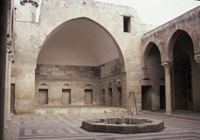
Figure 45. Courtyard.
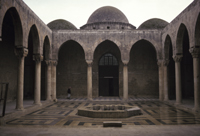
Figure 46. Courtyard.
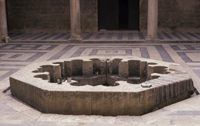
Figure 47. Basin.
The courtyard's original pavement in basalt and limestone survived in part into the age of photography, and the present reconstructed pavement does not follow the original pattern entirely.68 The striping of the pavement of the arcades, which may have been lacking in the Zâhirîyah, unifies it with the pavement of the courtyard.
The lobed stone basin in the center of the courtyard is octagonal, which I believe is an architect's habitual detail. Octagonal tanks also occur in the Madrasah al-Shâdhbakhtîyah, the Madrasah al-Kâmilîyah, the Palace of al-Malik al-Zâhir Ghâzî in the Citadel, and the Khânaqâh of Dayfa Khâtûn; of these I attribute the Madrasah al-Kâmilîyah and the Khânaqâh of Dayfa Khâtûn to this same Firdaus architect.
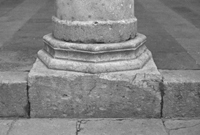
Figure 48. Arcade, column base.
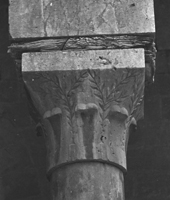
Figure 49. Bell-shaped capital.
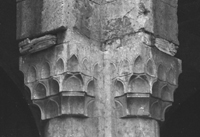
Figure 50. Southwest corner pier, capitals.
Older photos show the east and south arcades intact but unroofed, and the west arcade missing; it was apparently rebuilt under the French. At the southwest corner of the courtyard, the stub of the springing of the west arcade was squared off, suggesting that the arcades had already been consolidated from a more ragged state by the time they were first photographed.69 While there is no apparent evidence that the arcades were ever roofed, a flat wooden roof was obviously intended and surely was built.
The bases of the columns of the arcade appear to be Antique spolia, and share a common profile. However, in both the east and west arcades the second base from the north is octagonal rather than circular in plan.
The columns themselves are indeed a yellowish marble, as described by Sibt b. al-`Ajamî; they appear to come from no more than three sets, perhaps only two. The two columns on the octagonal bases are narrower than the rest, and form one set. They share with three of the others (a second set) a short collar at their lower ends. Three columns (possibly a third set) lack that collar, but as they may have been cut down from their original lengths, as suggested by Herzfeld, perhaps these columns and the other set of three formed one set of six, the members of which were shortened in different ways (by cutting off the top or cutting off the bottom). A full study of reused Antique columnry in Aleppo might yield interested results.
Two of the capitals, a matched pair, are weak imitations of Corinthian capitals, and the rest are muqarnas of various designs. In both the east and west arcades the northernmost capital is an almost smooth bell with small, rudimentary leaf tips and simple incised foliation.70 Herzfeld regarded these two capitals, along with the rest, as having been made for their present purpose, but that does not seem very likely to me. In view of the common material of the columns and the common profile of the two shapes of bases, it would be simplest to suppose that all the reused material came from various parts of the same Antique or Late Antique monument, and that these two capitals came from the same place. That supposition does firmly date them to the same period as the columns and bases, but explains why capitals contrasting so severely with the muqarnas set were used at all.
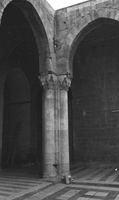
Figure 51. Southeast corner pier.
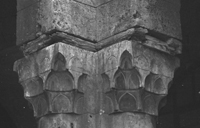
Figure 52. Southeast corner pier, capitals.
No two of the muqarnas capitals of the columns are entirely alike, and the capitals of the southeast corner pier differ from those of the southwest pier. They are unified by their common size, material, and overall arrangement in three tiers, but the selection of motifs (e.g., gored cells) is varied.
Most alike are the two capitals of the south arcade. While they are noticeably different (compare the backs of the cells of the lowest tier, which are convex in the eastern capital and flat or concave in the western one), they are recognizably the same design. Possibly they were cut by two different hands, or perhaps this is an example of the decorative principle of unity in variety.
The distribution of these capitals is not random. The two spolia capitals are symmetrically placed at the north ends of the two lateral arcades; the muqarnas capitals then lead south toward the south arcade, where the two corner piers, with their muqarnas double capitals, tie together the three arcades. The close similarity of two capitals of the south arcade, taken together with the placement of the spolia, suggests an intended progression toward the prayer hall, an effect Jalabi-Holdijk argues for on other grounds.71 While the arcade screens the prayer hall facade from the courtyard, the central dome of the prayer hall is plainly visible (the side domes less so, depending on the angle of view); this arrangement makes plain the layout of the building, while the north-to-south (or south-to-north) progression of the courtyard design ties together the îwân-hall and the prayer hall.
The corner piers have coursed, rather than monolithic engaged columns, and have more elaborate bases.
As eight capitals, along with two double capitals, were carved specifically for this high-budget project, the spolia capitals could hardly have been used just to fill a gap. They must have had some association that was considered appropriate. If they were part of the set of elements that included the columns and their bases, the building plundered for these elements may have had some appropriate association; I cannot suggest what that was, but the phenomenon is well established in Zangid and Ayyûbid Aleppo.72
Between the columns and the arches of the arcades are wooden imposts, or pads. As Herzfeld pointed out, these are the remains of tie-beams, as in the Zâhirîyah (the alternate hypothesis that they are merely imposts is unlikely in view of the fragment of original wood beneath the northern springing of the northernmost arch in the east arcade).
Creswell thought that the arcades were probably inspired by the more limited arcades in the Madrasah al-Zâhirîyah; Jalabi-Holdijk traces the Zâhirîyah's design farther back to the original campaign of the Madrasah al-Sharafîyah,73 whereas I date the Sharafîyah's arcades to its second campaign. That these arcades wrap around the courtyard is certainly an advance on the design of the Madrasah al-Zâhirîyah; there must have been many other instances of various solutions, however.
At the south end of the courtyard, beyond the arcade, lies the prayer hall, composed of three domed rooms of equal size, the dome of the central one being higher. Three doorways open into the prayer hall from the south arcade, the two outer ones offset to the axes of the east and west arcades. Much smaller doors connect it to flanking square chambers clearly intended as mausolea. In the qiblah wall are two windows, both flanked on each side by two air shafts or closets.74
The side domes are simple, resting on a collar that fudges the transition to the twelve-sided figure formed at the level of the top of the planar split pendentives. These lateral spaces, which are starkly plain, are separated from the main dome by rather low, pointed arches.
By deliberate contrast, the central domed space is rich with ornament, and the transition to the windowed dome is meant to create a unified space. The effect must have been strong before the windows were reglazed with clear glass (presumably heavy screens were used originally) and the mihrab was surrounded with neon tubes.
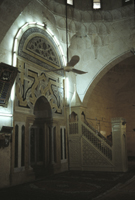
Figure 53. Mihrab.
This central dome rest on a collar that fudges the transition to the twelve-sided zone of transition proper, in which each side is completely opened by a small window. This zone, two courses high, rests in turn on a cornice carved with muqarnas cells. This cornice rests on split pendentives in which the surfaces of the split areas are treated as flat muqarnas compositions, while their central joints are cut away to accomodate muqarnas squinches that extend their lowest tiers down into the groin of the corners and rise to a small gored semidome. Structurally this is rather odd, but visually it works rather well.
The mihrab and its surround fill the center of the open area of the qiblah wall almost to the edges of the muqarnas split pendentives. In its overall form the mihrab is of the type first represented among extant monuments at the Maqâm Ibrâhîm at Sâlihîn; in its use of interlaced marble marquetry it continues the series represented at the Madrasah al-Shadhbakhtîyah and the Madrasah al-Sultânîyah. The filling of nearly the entire lunette above the mihrab is new and as flamboyant as anything else in the Ayyûbid architecture of Aleppo.
Enclosed within the knot directly above the apex of the mihrab semidome is a short inscription. Herzfeld read it as the signature of the artisan, which he could not entirely work out. Jalabi-Holdijk reads the inscription as `amal Hassân ibn `Annân, which is plausible but leads to no further connections. In the arch of the lunette is inscribed Qur'ân 38:17–23,75 which, as Jalabi-Holdijk points out, contains the word mihrâb, and is on that count appropriate for use here. The larger meaning of the passage emphasizes King David's greatness and submission to Allâh, which, I suspect, was also thought relevant somehow. Jalabi-Holdijk also reads in the interlace the phrase lâ illâha illa Allâh, Muhammad rasûl Allâh, but while it is possible that the design was so intended, this interpretation may be merely reading in: it is easy to discover the requisite letters in such a design.
While the two chambers to either side of the prayer hall can be entered from it through small doors, they are more obviously intended to be entered from the long halls of the side wings, to which large doorways open. Each of the chambers has a window in its side wall, and in the qiblah wall a window flanked by air shafts, as in the prayer hall. Both are vaulted in the same manner as the side domes of the prayer hall. The side wings contain halls, each covered by three domes, again similar to the corner chambers. These are given over to tombs now, but must originally have been used for the educational functions of the institution.76
The residential and service areas of the building are packed into the north wing. It is composed of the îwân-hall on the courtyard; another, deeper îwân-hall open to the exterior, addorsed to the courtyard îwân-hall; north-south corridors running straight through from the courtyard to the exterior on either side of the paired îwân-halls; corridors connecting the portal with the east arcade and the western north-south corridor with a doorway to the exterior corresponding in plan to the portal; latrines; residential apartments; and other small chambers. Jalabi-Holdijk illustrates and provides an excellent discussion of the nonpublic areas of the north wing, which I have not seen.77 In these apartments one may note the absence of decoration, the use of the wooden beams as lintels supporting masonry, and possibly (if the reconstruction is accurate) the use of oculi in the parapet walls surrounding the courtyard.
The two northern corners of the building were extended beyond the rectangle of the plan, probably in the course of construction, and were added to later on, although the various plans of the building show different conclusions as to what is original and what is later addition. It is worth remembering that this building stood within its grounds, which were surrounded by an enclosure wall, and that the building was open to the grounds to the north. Here the original plan may simply have been too confined to accomodate those functions (and residents) that it was thought should rightfully be housed in the main building, rather than in other buildings on the grounds. These were the places where, as Sibt b. al-`Ajamî remarks, the building has been shortened.
Sibt b. al-`Ajamî lists the functions of the building. It is always dangerous to make one-to-one connections between functional descriptions and physical structure, and it is interesting that Sibt b. al-`Ajamî mentions no masjid. However, Kâmil Ghazzî, writing in the 1920's, located the madrasah in the north part of the building, along with the kitchen and the ribât, and placed the turbah in the east and west wings, flanking the courtyard.
The great îwân-hall on the courtyard occupies nearly the full height of the building and is covered by a mitered vault. It is a bit shallower than it is wide. Each of the lateral walls contains three air shafts, and the back (northern) wall originally contained three grilled windows equipped with shutters, which opened onto the north îwân-hall, cooled by shade and the garden beyond, providing good ventilation.
The north îwân-hall is deeper than it is wide, and is covered with a barrel vault. That one îwân-hall should have been covered with a mitered vault and the other with a more sensible and economical barrel vault suggests that the mitered vault was somehow stylish, and thus was considered important for the publicly visible courtyard îwân-hall. Each of the lateral walls of the north îwân-hall is equipped with two air shafts, and there is a door in each one, close to the back wall, opening into the corridors that link the courtyard to the garden.
Near the northwest corner, on the roof, is a thin cylindrical minaret, obviously later than the main building (though Herzfeld seems to have thought it original). The cylindrical form is the next phase after square and octagonal minarets, and Jalabi-Holdijk fairly dates this example as late Ottoman or even post-Ottoman; her informant dated it to 1250 A.H.
The Madrasah al-Firdaus is unlike other Ayyûubid madrasahs in Aleppo in several important respects. While Dayfa Khâtûn was evidently a truly pious woman who patronized religion throughout her life, and while the function of the building as a tomb for her family was traditional in Aleppo, as an institution the Firdaus was more comprehensive a foundation than had been seen in Aleppo previously. There must have been a public, political point to that difference.
The building itself is substantially larger than other madrasahs in Aleppo, and its plan shows clearly that it was specifically designed to open out into its ample grounds, another innovation. The intriguing use of spolia, the varied capitals of the courtyard, the grand mihrab, possibly even a gilded portal inscription, all mark the building out as something special.
Even the textual evidence is unusual. There are two sides to this evidence. The extensive devotional inscription within the building is unparalleled, and like the portal inscription, with its Paradisiac imagery, is addressed to the pious inmates of the institution. The Solomonic theme sounded by Sibt b. al-`Ajamî (stone brought from many places) and the extensive rhetoric expended in praise of the building both point to a political awareness that the building was grand for a reason.
The striking resemblence of the Firdaus as an institution to multipart complexes of the later Persian-speaking world, and the distinctive exterior îwân-hall, which may have been a response to the Madrasah al-Mustansirîyah in Baghdad, are the clues to the true political significance of the Firdaus. Those complexes were built by powerful rulers to demonstrate their importance in the religious affairs of their culture; the Mustansirîyah, possibly the common prototype, was built by a caliph intent on restoring the ancient glories of the Caliphate.
In short, the Madrasah al-Firdaus was intended to show that Dayfa Khâtûn and her branch of the Ayyûbid dynasty were every much as legitimate, powerful, and important to the most central aspect of cultural life as the Sultan in Cairo or the Caliph in Baghdad.
Why Dayfa Khâtûn thought it desirable to make such a political statement is a matter yet to be clarified, although the political implications of the Firdaus suggest it was conceived as a ruler's monument, and thus was either planned for al-Malik al-`Azîz before his death or for Dayfa Khâtûn only after she became regent. In any event, of all the rulers of Aleppo, none had more motive to declare the might and right of their dynasty than Dayfa Khâtûn, of noble lineage, born in the Citadel itself, and wife of the greatest Ayyûbid builder, al-Malik al-Zâhir.
As for the style of the building itself, the discipline of the Plain Style was retained, with embellishments limited to areas traditionally decorated (capitals, inscription, vaulting of the qiblah dome). The Firdaus is grand without being grandiose.
The portal of the Firdaus is so close to that of the Kâmilîyah that I attribute both buildings to the same architect without hesitation. The handling of the inscription band or panel aside, the two portals share a very plain back wall and very similar muqarnas vaults. In the Firdaus the frontal arch has been adjusted yet further to the shape of the muqarnas, so that the somewhat overemphasized scalloped lunettes of the Kâmilîyah are reduced to more harmonious dimensions. The similarity of courtyard basins is another habitual detail linking the two monuments. As the two buildings were founded in the same period for prominent women of the Ayyûbid house, these are sufficient parallels to make an attribution, but the architect remains anonymous; in this study he is the Firdaus architect.
The Firdaus is built out from the north onto a large platform, as the site slopes north to south. On the west it is apparent that up to five courses are large stones (up to about the interior floor level, or above), with smaller ones above. Down toward the south end of the west side the large stones rise to top of wall; the south exterior is all large stones.
The portal projects 3.5 cm; both portal and adjacent walls are medium toothed medium to long stroke, and the muqarnas is medium- or finely toothed medium stroke—there is no extra fine finish. All arched doors without monolithic lintels had wood lintels. Course heights, north side of portal bay, exterior face: partly buried, 49.5, 49, 48, 49.5, 49; southwest corner of the courtyard îwân-hall: partly buried, 32, 49, 50, 49. The courtyard stones are medium toothed, medium to long stroke; to the east of the central door to prayer hall: 48 (partly buried?), 27, 27.5, 27.5, 27, 27, 30. The interior of the prayer hall is medium toothed short stroke to coarsely toothed long stroke, rather haphazard and evidently meant to be covered by plaster.
The building customarily referred to by historians of architecture as the Khânaqâh fi'l-Farâfrâ stands in the Fârafrâ quarter, north of the Citadel.78
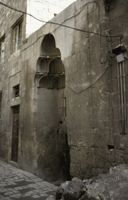
Figure 54. Khânaqâh of Dayfa Khâtûn, portal.
An inscription over the doorway begins by quoting Qur'an 35:34–35, which is praise of Allah offered by souls in heaven (Gardens of Eden, jannat `adn):
And they shall say, “Praise belongs to Allah, who has rid us of all grief. Surely our Lord is all-forgiving, all-thankful, who of his bounty has settled us in a place of residence (dâr al-muqâmah) wherein neither weariness nor fatigue assails us.”
It continues with a foundation text omitting the name of the founder:
This blessed ribât was founded during the reign of our lord the Sultân al-Malik al-Nâsir Salâh al-Dunyâ wa'l-Dîn Yûsuf b. al-Malik al-`Azîz Muhammad b.al-Malik al-Zâhir Ghâzî b. Yûsuf b. Ayyûb, defender of the Amîr al-Mu'minîn [the caliph] in the year 635/1237–38.
Herzfeld identified this building with the “khânaqâh built by Dayfa Khâtûn” listed by Ibn Shaddâd and his continuators as lying within the Bâb al-Arba`în, arguing that the location is apropos, the date of foundation falls within her years of power, and none of the other listed khânaqâhs or ribâts is a plausible alternative. I cannot see any support for his argument that it was a converted residence.
That the building could be called a ribât in its inscription and a khânaqâh by topographers who also used the word ribât may indicate some disjunction between ordinary usage and the literary tone of the inscription. This is all the more remarkable as Sibt b. al-`Ajamî writes, “written over its portal (bâb) is ‘built in 635’.” However, this last piece of evidence clinches the identification. The language of the building's inscription parallels Ibn Shaddâd's remark that Dayfa Khâtûn's Madrasah al-Firdaus contained a tomb, madrasah, and ribât, mentioning no khânaqâh. In that context he was speaking of the functions of the building, not separate architectural components; in the context of the Khânaqâh of Dayfa Khâtûn the word khânaqâh would appear to mean a building entirely dedicated to the purpose common to both khânaqâhs and ribâts, that is, Sûfî religious study.
Heinz Gaube points out Ibn Jubayr's remark, decades before the construction of the building, that (in Damascus) people call ribâts khânaqâhs,79 which shows the equivalence of the terms.
That so few ribâts are listed by the topographers, such as Ibn Shaddâd, who calls this building a khânaqâh, may mean that those ribâts had some rare (particularly ascetic?) characteristics. In any event, formally, as in its inscription, this building was called a ribât, although otherwise it was called a khânaqâh, it being understood that the two were functionally equivalent.
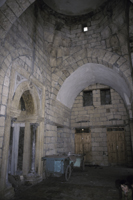
Figure 55. Interior.
The building, though amply proportioned, is entirely less grand than the Firdaus, and so are its portal and inscription. Herzfeld concluded that it was a state, not personal foundation of Dayfa Khâtûn, and that for that reason it was credited in its inscription to the ruler, her grandson.
Yet there are parallels with the Firdaus's inscription. Not only is the Qur'ânic citation appropriate for a residential building with a pious purpose, it continues the theme of gardens introduced by the Qur'anic citation in the portal inscription of the Madrasah al-Firdaus. Where the Firdaus citation promises the delights of Paradise, this citation mentions only relief from unpleasantness—this was, after all, a less glorious institution.
The portal itself is small, and as it is now well below street level it makes a quite modest impression. It is a simple bay topped by a vault composed of two tiers of muqarnas and a semidome. The two benches are so small one wonders if they are original. The portal originally projected a few centimeters from the building's very plain street facade, with which it was in bond. To the west, these larger stones give way to smaller, still regular courses—possibly replacing the original masonry.
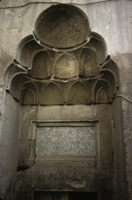
Figure 56. Portal, muqarnas.
The absolutely plain door frame, with its monolithic lintel, is topped by a plastic frame surrounding the five-line inscription slab. Some centimeters above, the vault begins, directly and, given the scale, almost intimately. In terms of the “Muqarnas Questionnaire” in Appendix A, this muqarnas is just about twice as deep as it is wide. It springs square from the back of the bay, without a cornice. Squinchlike cells in the back corners are subdivided into halves. The two tiers are equal in height and depth. From beneath, the geometry is octagonal. There are no “flues” rolled square brackets, or branched brackets. In the second tier the two corner cells are gored. The semidome at the top of the vault is smooth, not gored, and is filled with an incised polygonal design (no doubt once painted) in a hexagonal geometry, jointed along the edges of the polygons. The frontal arch follows the profile of the muqarnas, and is a shallow, undistinguished perpendicular zone, adjusting the various angles of the cells to the facade. Thre is no outer arch or frame, nor any decorative archivolt. The geometric exercise found in the semidome seems to have migrated from the decorated archivolts of earlier designs; the same device was used again in the minor portal of the Madrasah al-Kâmilîyah-`Adimîyah. If the semidome was painted, would not the muqarnas have been, too?
The plan is more like the Firdaus than may at first appear. Both buildings have similar bent entries; both bent entries bring the visitor to the northeast corner of the courtyard. Arcades aside, the general layout of the public spaces of the buildings is quite similar, with the large îwân-halls on the north side, the octagonal basins, and the prayer halls to the south with their tripartite facades; however in the Khânaqâh of Dayfa Khâtûn residential cells fill both lateral sides on both floors. The separate residential unit to the east, which seems quite cramped, could have been for the professional clerical staff, but the domestic arrangements of the building remain to be explicated. To make matters more complex, the area east of the portal between this residential unit and the street was probably part of the khânaqâh but does not exist now in its original form.
The original stairs to the upper story are evidently those in the passage leading from the courtyard to the eastern residential unit.
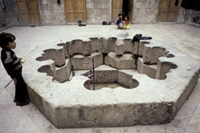
Figure 57. Basin.
The courtyard's octagonal lobed basin is about the same size as that of the Firdaus, but occupies proportionally much more of the courtyard's area. The facades of the east and west sides are quite plain, notable for the wooden beams running continuously at the top of the first-story doorways and second-story windows (the former attested, the latter plausibly restored). The lintels overlying these beams are relieved by slightly pointed segmental arches. This simple elevation was carried around the north corners onto the sides of the facade of the îwân-hall, where one bay of doorway and window flanks the large arch on each side.
The îwân-hall is a pointed barrel vault. Its frontal arch and lower side wall are constructed of large ashlars and the rest, before reconstruction, was composed of roughly coursed small stones. I cannot be sure that this small stonework is original, but in any event the back wall of the îwân-hall has been reconstructed in large ashlars.
The prayer hall facade breaks with the elevation of the east and west sides, consisting of a large central doorway topped by a pointed arch and two side doorways, topped by arched windows. Here wooden beams run beneath the lintels of the side doorways, as in the side facades, across the central doorway below the springing of the arch, and across the facade at the level of upper beams on the side facades, broken only by the arch of the central doorway.80 The central doorway retains a geometric joinery soffit in wood, with pivot holes at the corners nearest the courtyard for the now-missing doors that closed it. Presumably the side doors were similarly equipped, and their arched windows, along with the upper part of the central doorway, were filled with wooden screens.
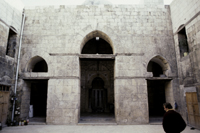
Figure 58. Prayer hall facade.
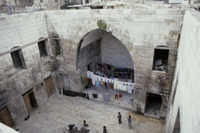
Figure 59. Īwân-hall.
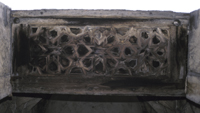
Figure 60. Joinery soffit.
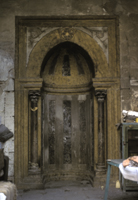
Figure 61. Mihrab.
The prayer hall is composed of a tall central domed bay flanked by barrel vaults over bays of equal size, corresponding to the prayer hall facade. To east and west are chambers accessible by two doors each and lit by two windows each; I do not know what their function was, but they could have been tombs.
The central dome is constructed of brick on a stone collar that rests on an octagonal zone of transition, with the usual fudging between the octagon and the collar. The octagonal drum has a window in each face and rests on muqarnas pendentives two tiers high, with a bracket below. In the lower tier, brackets between the cells join beneath the central, gored cell in the upper tier.
The marble mihrab is of typical form and fine execution, in the style of the mihrab in the Shâdhbakhtîyah, although simpler. It has a complex and deeply molded frame that turns inward at the top and bottom of the cylinder of the niche, framing fine colonnettes with matching bases and capitals, the latter Crusader spolia. The semidome is divided into panels of different colors, as is the cylinder. The inlaid panels in the cylinder have, at top and bottom, what appear to be flat imitations of bases and capitals; I imagine these were painted to fulfill the illusion. In the simple loop inlays that fill the spandrels, and in a medallion at the top of the main arch, are small areas of Cosmati work; the medallion perhaps echos the geometricly carved semidome at the top of the portal.
As this building was built only two years after the Firdaus was finished, it may be possible to determine whether it was designed and built by the same hands. The portals differ considerably, partly due to their different scale, but their designs are sufficiently close that they can plausibly be considered the work of the same designer. A possibly significant detail is the completely plain course between the inscription and the vault. In overall plan, as I pointed out above, there are considerable similarities. As for decoration, the Khânaqâh of Dayfa Khâtûn lacks the Firdaus's ablaq pavement and its arcade, but its basin is very similar; likewise, while the Firdaus's mihrab is much larger and grander, that of the Khânaqâh of Dayfa Khâtûn is of the same type.
Given the possible scope of imaginative variation in design both within the work of a single architect and within the style of his age, these similarities are persuasive but not conclusive. Perhaps a more detailed study of structural and masonry details than I have had time to conduct would yield firmer results. It is entirely plausible to see the Khânaqâh of Dayfa Khâtûn as another work of the Firdaus architect. However, as the points of comparison between the Khânaqâh of Dayfa Khâtûn and the Firdaus are somewhat different than those I used to connect the Firdaus and the Madrasah al-Kâmilîyah, the attribution of all three buildings to one architect may be considered tentative.
The Khânaqâh of Dayfa Khâtûn shows that khânaqâhs, or ribâts, had the same plan as madrasahs, which is of course only logical. It is also a fine example of the use of wood to strengthen and enliven stone facades, especially in its preserved geometric soffit, and possesses a fine mihrab. It is fully representative of the Plain Style, and its scale and relative simplicity indicate just how exceptionally grand Dayfa Khâtûn's Madrasah al-Firdaus was for its day.
The portal is mainly extra fine, with some medium toothed short stroke, medium toothed medium stroke, and medium toothed long stroke. The surround of the inscription is medium toothed medium to long stroke, as is its frame. The muqarnas is extra fine. The basalt, of course, is smooth faced. The setback is 2.5 cm., and stones crossing it are extra fine, then medium toothed medium stroke on the set-back face. Portal course heights, west side: partly buried, 49, 43, 43, 45, 47. At the east side there are no stones crossing the setback, but a clean break to new masonry. To the west, the original stones are medium toothed short stroke, medium toothed medium to long stroke, 29–31 cm. high. The courtyard facades are medium toothed short to medium stroke, with some medium toothed long stroke. The prayer hall inside is medium toothed medium to long stroke. Course heights, qiblah, east of mihrab: partly buried, 28, 30, 29, 31, 30.5, 31, 31. The east freestanding pier of prayer hall facade: partly buried, 41, 51, 50, 50. The interior of the passage from portal to courtyard is medium toothed medium to long stroke.
The Plain Style never dominated completely in Aleppo. Strongly plastic moldings appear throughout the Ayyûbid period, and the portals of the Bîmâristân Arghûn, the Palace of al-Malik al-Zâhir, and the Madrasah al-Sharafîyah show the appeal of plastic ornament. The Palace of al-Malik al-Zâhir—or perhaps the palace to which the portal of the Bîmâristân Arghûn belonged—introduced ablaq from Damascus, an innovation so appealing that it appears even in so plain a building as the Madrasah al-Firdaus, although only in the paving of the courtyard. Color was well suited to the flat expanses of Plain Style buildings, and it became even more popular in the later seventh/thirteenth century, as the motifs of the Ayyûbid period were reworked, recombined, and elaborated.
Although the great Ayyûbid institutions built after the death of al-Malik al-Zâhir in Aleppo may seem to represent a classical moment of balance in design, that may well be because they were designed by the same architect, the Firdaus architect, whose identity is unknown, because they were built during a relatively short period, and because some of their original color has been lost. Certainly the portal of the Madrasah al-Sharafîyah, designed at about the same time by Abu'l-Thanâ' b. Yâqût, proves that a flashier style was appreciated, and it is this flashier style, in accord with the trend of Mâmluk architecture in Damascus and Cairo, that appears to have been followed over the next century.
Nevertheless, the Plain Style brought a lasting change to Aleppan architecture: it killed off the fascination with plasticity that began with the classical revival of the late fifth/eleventh century and is exemplified by the minaret of the Great Mosque. Generations of architects brought up in the company of buildings of the Ornamented Style found new means of decoration—ablaq and colorful inscriptions and geometrically patterned fields—that suited the flatness and greater bulk of the architecture of the seventh/thirteenth century.
1. Ibn Shaddâd A`lâq (Aleppo section), pp. 107–08; Ibn al-Shihnah, text, pp. 111–12, trans., p. 112; Sibt b. al-`Ajamî, Kunuz, trans., p. 79; Sourdel, “Professeurs de madrasa à Alep,” p. 91; Creswell, “Cruciform Plan,” p. 15, pl. 3–4, fig. 4; Sauvaget, Inventaire, no. 26, pp. 81–82, pl. 1 (view of courtyard to northwest before reconstruction; bound between pp. 80 and 81 in offprints), pl. 7b (view of mihrab); Herzfeld, MCIA Alep, pp. 273–76, pl. 118–21; Gaube and Wirth, Aleppo, p. 411, no. 660, incorrectly giving a completion date of 1291 (evidently a typographical error for 1219, which in turn is based on Ibn al-Shihnah's incorrect date of 616); Korn, “Ayyubidische Architekur,” catalogue, “Aleppo,” no. 39.
2. Rana Jalabi-Holdijk, Al-Madrasa al-Firdaus in Aleppo: a chef-d'oeuvre of Ayyubid architecture, M.A. dissertation, American University in Cairo, 1988, pp. 11–34.
3. Ibn Khallikân, trans., v. 4, pp. 422–23.
4. Cf. Ibn al-Shihnah, trans., pp. 115–16, n. 2.
5. Shown correctly on Creswell's plan but not on Herzfeld's.
6. Herzfeld's drawing of soffit is incorrect in showing another ring to the design of the soffit, where in fact the raked molding separates the muqarnas from the frontal arch.
7. Lorenz Korn suggests that “al-nusbah” can possibly be read in inscription (personal communication, 1 September 1998).
8. For the Great Mosque, Allen, “Some Pre-Mamluk Portions of the Courtyard Facades of the Great Mosque of Aleppo,” for the Baptistry, Allen, Classical Revival, pp. 73–74; for the Qubbat Yûsuf, Archibald Walls and Amal Abul-Hajj, Arabic Inscriptions in Jerusalem: A Handlist and Maps, London, 1980, p. 15; Marguerite Gautier-van Berchem and Solange Ory, La Jérusalem musulmane dans l'oeuvre de Max van Berchem, Lausanne, 1978, p. 67 (illustration); published by van Berchem in MCIA Jérusalem, v. 2, pt. 1.
9. Cf. Creswell's photographs of the courtyard, pl. 3 and 4.
10. Herzfeld thought this southern arcade, the only one of the pair standing in his day, had never been roofed, but it is not entirely clear why.
11. Bernard O'Kane, personal communication (e-mail of 8 September 1993).
12. Hamilton, The Structural History of the Aqsa Mosque: A Record of Archaeological Gleanings from the Repairs of 1938–1942, Dept. of Antiquities in Palestine, London, 1949; see reconstruction drawing fig. 20, p. 37.
13. Theodericus Wirtzburgensis, writing ca. 1172, trans. Aubrey Stewart (Theoderich's Description of the Holy Places (Library of the Palestine Pilgrims' Text Society, v. 5, no. 4), in F. E. Peters, ed., Jerusalem: The Holy City in the Eyes of Chroniclers, Princeton, 1985, pp. 321–22.
14. Op. cit., pp. 37ff., especially p. 44.
15. Alternately, the Aqsâ arcade may just have proved practical enough to adopt in Aleppo—but not all later madrasahs in Aleppo have such arcades, useful as they are in the rain.
16. Ibn Shaddâd A`lâq (Aleppo section), p. 103; Ibn al-Shihnah, text, pp. 111–12, trans., p. 112; Ibn al-`Adîm, Zubdat al-Halab, v. 3, p. 194; trans. Blochet, ROL, v. 5, 1897, pp. 37–107, p. 66; Sibt b. al-`Ajamî, Kunuz, trans., pp. 69–72; Creswell, “The Origin of the Cruciform Plan of Cairene Madrasas,” BIFAO, v. 21, 1922, pp. 1–54, pp. 15–16, fig. 6, pl. 4B, 5A; Kâmil b. Muhammad al-Ghazzî, Nahr al-dhahab fî ta'rîkh Halab, Aleppo, n.d. [1342/1923?], v. 2, pp. 124–28; Herzfeld, MCIA Alep, pp. 276–82, inscr. 147–150; Herzfeld, “Mshattâ, Hîra und Bâdiya,” fig. 17, the mihrab; Herzfeld, DS–II, p. 39, the minaret; Sauvaget, Inventaire, no. 23, p. 81, suggesting the demolition of the “minaret moderne qui surcharge inutilement la voûte du portail”; Dominique Sourdel, “Les professeurs de madrasa à Alep aux XIIe–XIIIe siècles d'après Ibn Šhaddâd,” BEO, v. 13, 1949–51 [1951], pp. 85–115, pp. 88–89; Janine Sourdel-Thomine, “Une inscription inédite de la madrasa Sultaniya à Alep,” Annales Archéologiques Syriennes, v. 3, 1953, pp. 67–70, a Mamlûk inscription regarding a neighboring Zangid building; J. Lauffray, “Une madrasa ayyoubide de la Syrie du Nord: La Soultaniya d'Alep, étude architecturale,” Annales Archéologiques Syriennes, v. 3, 1953, pp. 49–68; Gaube and Wirth, Aleppo, p. 382, no. 342; Allen, “Observations on Ayyûbid Architecture in Aleppo,” `Ādiyât Halab, v. 6–7, 1992, pp. 19–36, Ar. summary pp. 285–86; Korn, “Ayyubidische Architekur,” catalogue, “Aleppo,” no. 55.
17. See also al-Ghazzî, op. cit., pp. 126–27.
18. This passage, attributing the building to al-Malik al-Zâhir, was read correctly by Herzfeld, but by error he interpolated the name of al-Malik al-`Azîz Muhammad as founder.
19. Lauffrey declined to commit himself on the date of the mausoleum in relation to the east and west wings, and needlessly posited three campaigns.
20. Creswell thought the entire minaret was a later addition, “Cruciform Madrasah,” p. 40; his illustration shows nothing above the muqarnas cornice. Herzfeld implies that the minaret was part of the original building, on the basis of a comparison with that of the Mashhad of Nabî Yûsha` in Ma`arat al-Nu`mân, dated 604/1207–08, also an octagonal minaret on a portal with a mitered vault.
21. One of many such discoveries made by both Christians and Muslims; see Herzfeld, MCIA Alep, pp. 118–19, and for this instance, Ibn al-`Adîm, Zubdat, v. 1, p. 262.
22. Herzfeld, MCIA Alep, p. 114, n. 1; Ibn al-`Adîm, Zubdat, v. 1, p. 288, my translation.
23. MCIA Alep, no. 31, pp. 80–81. It is reported in the Répertoire as reused in the masonry of the north side of the Citadel; Herzfeld said it was “at present” in the Upper Maqâm, where I saw it in 1979 before it was moved outdoors during the course of the reconstruction of the building.
24. Ibn Shaddâd, A`lâq (Aleppo section), pp. 39–40; Ibn al-Shihnah, text, pp. 74–75, trans., pp. 72–75; Ibn al-`Adîm, Zubdat al-Halab, v. 3, pp. 164–65; this information is not in the ROL trans. by Blochet; Herzfeld, MCIA Alep, pp. 132–34, inscr. 68–69; Herzfeld, DS—II, pp. 47–48; Sauvaget, Inventaire, pp. 72–73; Gaube and Wirth, Aleppo, pp. 156, 169 (plans of the Maqâm and the Citadel), 382, no. 348; Allen, Classical Revival, pp. 62, 68–69, mostly about the Lower Maqâm.
25. There is an inscription from a zardkhânah on the Citadel (see Chapter Five, “Palace of al-Malik al-Zâhir”), but it is later, from another arsenal: MCIA Alep, pp. 136–37, inscr. 71.
26. Missing in Herzfeld's plan.
27. MCIA Alep, pl. 30c, 39a, 43c (plan), 49a, and 49b.
28. See Chapters Five and Six, and also the description of the Madrasah al-Sharafîyah, below.
29. Creswell, Cruciform Plan, pp. 23–24, fig. 8 (plan); Sauvaget, Inventaire, no. 27, p. 82, pl. 8a, the îwân-hall; Herzfeld, MCIA Alep, pp. 305–06, pl. 111b, 135,a, 136a; Gaube and Wirth, Aleppo, no. 657, pp. 84, 411; `Adil Najm `Abû, “Al-madrasah fi'l-`imârat al-ayyûbîyah fî sûrîya,” Annales Archéologiques Syriennes, v.!24, 1974, pp. 75ff., includes a plan of the building as restored, p. 95.
30. Ibn Shaddâd, p. 109; Ibn al-Shihnah, text, p. 114, trans., p. 120.
31. Incorrectly given as 662/1225 in Sauvaget's translation.
32. Korn, “Ayyubidische Architekur,” catalogue, “Aleppo,” no. 90. For `Alâ' al-Dîn b. Abi'l-Rajâ' see Eddé, op. cit., pp. 253–54; he founded a madrasah extra muros, very likely next to his wife's institution, and died in 654/1256.
33. The inscription on the lintel of the restored portal is dated 1331/1912–13, but it is visible in Herzfeld's pl. 136b, which shows the ruins of the muqarnas vault before the construction of the classicizing round arch that presently frames the top of the portal, and which is therefore even later.
34. Ibn Shaddâd A`lâq (Aleppo section), p. 106; Ibn al-Shihnah, text, p. 112, trans., p. 114; Creswell, “The Origin of the Cruciform Plan of Cairene Madrasas,” BIFAO, v. 21, 1922, pp. 1–54, pp. 7–8, 16–23, pl. 7–8A; Herzfeld, MCIA Alep, pp. 312–315; Gaube and Wirth, Aleppo, p. 361; Kâmil b. Muhammad al-Ghazzî, Nahr al-dhahab v. 2, pp. 268–71; Sauvaget, Inventaire, no. 33, p. 86; plan in Michael Meinecke, Die mamlukische Architektur in Ägypten und Syrien, p. 126, fig. 85; Korn, “Ayyubidische Architekur,” catalogue, “Aleppo,” no. 29, 95.
35. Text, p. 107, trans., p. 101.
36. Anne-Marie Eddé, “Une grande famille de shafiites alépins: Les Banû l-`Agamî aux XIIe–XIIIe siècles,” Alep et la Syrie du Nord, v. 62 of Revue du Monde Mulsuman et de la Méditerranée, 1991–94, pp. 61–71. For previous efforts, see Herzfeld, MCIA Alep, p. 315–19 (Madrasah al-Karîmîyah); Ibn al-Shihnah, trans., pp. 101–02, n. 5; and Dominique Sourdel, “Les professeurs de madrasa à Alep,” p. 90, 107.
37. Kunuz, MS. ff. 51r–52v; trans., pp. 74–79; thanks again to Heinz Gaube for help with access to the original text.
38. That is, his entry for the Khânaqâh of Shams al-Dîn, ff. 73v–74r, trans., p. 111; see my discussion of Shams al-Dîn, below.
39. Also used to revet the Citadel.
40. Herzfeld read this word, in the inscription at the Maqâm Shaykh Fâris, as al-nasîyya, giving it a Sûfî meaning (p. 260–61). But the Repertoire gives al-nusbah, and the inscription on the mihrab of the Sharafîyah appears to give the same spelling.
41. Not Yaqûb, as trans. by Sauvaget, p. 75, l. 20.
42. For identifications of most of these titles, see Sauvaget, trans., p. 77.
43. Sixteen days after the fall of the city.
44. Capital letters in parentheses refer to Creswell's plan.
45. This inscription was not recorded by Herzfeld; perhaps the mihrab was plastered over in his day.
46. Herzfeld, MCIA Alep, pp. 260–62.
47. This was during the reign of al-Malik al-Zâhir, 589–613/1186–1216, so Herzfeld attributed this construction to 1201, the date of the father's entombment; the building was restored by someone else in 648/1258, as yet another inscription records.
48. MCIA Alep, p. 313, no. 166.
49. See Chapter Nine.
50. Écochard, “Notes d'archéologie musulmane,” pp. 98–108.
51. Gaube and Wirth, Aleppo, p. 84 and fig. 17.
52. Cf. Sheila Blair, “A Medieval Persian Builder,” Journal of the Society of Architectural Historians, v. 45, 1986, pp. 389–95.
53. Ibn Shaddâd A`lâq (Aleppo section), p. 108; Ibn al-Shihnah, text, pp. 113, trans., p. 117–18; Sibt b. al-`Ajamî, Kunuz, MS., f. 54v–56v, trans., pp. 79–84; Creswell, “Cruciform Plan,” pp. 7, 16, fig. 6, pl. 5b–6b; RCEA, v. 11, no. 4084, pp. 56–57 (exterior inscription), no. 4086, p. 58 (duplicate of 4081); Kâmil Ghâzî, Nahr al-dhahab fî târîkh Halab, 3 v., Aleppo, 1342–44/1923–26(?), v. 2, pp. 289–90; Sauvaget, Inventaire, no. 31, p. 84 and pl. 9a, showing part of the northwestern courtyard; Sauvaget, Alep, pl. 33, showing the courtyard before restoration, when it was planted with trees trained on an arbor; Herzfeld, MCIA Alep, pp. 297–302, pl. 128–33; Sourdel, “Professeurs de madrasa à Alep,” p. 91; Gaube and Wirth, Aleppo, p. 411, no. 662; Rana Jalabi-Holdijk, Al-Madrasa al-Firdaus; Korn, “Ayyubidische Architekur,” catalogue, “Aleppo,” no. 99.
54. Translation slightly modified from Arthur J. Arberry, The Koran Interpreted, London, 1955, p. 205. The Qur'ânic context, reproach of the Jews and Christians for falling away from divine instructions, seems not to be relevant here.
55. Op. cit., fig. 103a, c. Herzfeld did not see this part of the inscription, and indeed seems to have forgotten about even the part falling within the portal bay, which he drew in his elevation of the portal; regarding Creswell's report he remarked that the date is at least a year too early to fall within Dayfa Khâtûn's regency. He concluded, oddly, that the building was begun in 633 and finished in 634.
56. See Chapter Five; also Humphreys, From Saladin to the Mongols, p. 229, on her assumption of the regency.
57. The portion under the east arcade was also published as RCEA v. 11, no. 4086, inexplicably dated 1400. The portion within the courtyard îwân-hall was recorded by Sibt b. al-`Ajamî, who is quoted by Ghâzî, Nahr al-dhahab, pp. 291–292.
58. On the term khashkhâshah see M. M. Amin and Laila A. Ibrahim, Architectural Terms in Mamluk Documents, Cairo, 1990, p. 42. This might have been a tiled and openwork dome over a well or reservoir.
59. Ibn Wâsil provides a similar encomium, Mufarrij, v. 5, p. 312.
60. Trans., pp. 83–84.
61. Ibn al-`Adîm, text, v. 3, p. 263.
62. There was a tomb-cover shroud, reported by Herzfeld and Kâmil Ghazzî (Nahr al-dhahab, v. 2, pp. 289–90) bearing an inscription dated 1310/1892 claiming the tomb to be that of `Alî b. Abî Tâlib, otherwise widely reputed to be buried at Najaf; this is a transparent fabrication, though interesting because it credits Sayf al-Daulah with translating `Alî's coffin from Najaf. Jalabi-Holdijk reports several other tombs in the Firdaus, apparently suppositious; she shows that one of these is probably that of Shams al-Dîn al-Khâbûrî, the first professor.
63. Ibn ' al-`Adîm, text, v. 3, p. 267, her obituary (calling her al-malikah al-khâtûn). This does not quite say whether al-Malik al-`Azîz was ever translated elsewhere. The historian and astronomer Ibn Wâsil (born in Hamâh two years before al-Malik al-`Azîz) says that she died in the Citadel and was buried in the enclosure (hujrah) in the Citadel in which her son al-Malik al-`Azîz was buried (Mufarrij, v. 5, p. 312).
64. For the Madrasah al-Mustansirîyah see Hansjörg Schmid, Die Madrasa des Kalifen al-Mustansir in Baghdad; and Nâjî Ma`rûf, “Muqaddimat fî ta'rîkh al-Mustansirîyah wa `ulama'ihâ,” Bulletin of the College of Arts and Sciences Baghdad University, v. 3, 1958, pp. 84–106, especially the list on pp. 97–99.
65. Muhammad Mutlaq, “Fann al-yn imârat fi'l-madâris al-ayyubîyah bi-Halab,” `Adiyat Halab, v. 2, 1976, pp. 261–78, p. 272.
66. Herzfeld, MCIA Alep, pp. 289–91, pl. 127c; on p. 290 Herzfeld gives details on this anonymous woman, including her date of death, 622/1225. As the wife of Dayfa Khûtûn's father's brother, she was Dayfa Khûtûn's aunt by marriage. I have not seen this tomb, and it is not listed in Gaube and Wirth, Aleppo, so I fear it may be lost.
67. Creswell, MAE 2, p. 190.
68. Jalabi-Holdijk, compares the available views and criticises details of the restoration, pp. 50–51.
69. Herzfeld, MCIA Alep, pl. 130b.
70. Herzfeld, MCIA Alep, pl. 129c shows the capital of the west arcade before its reconstruction.
71. Op. cit., pp. 53–54
72. Allen, Classical Revival.
73. Op. cit., pp. 60, 107, and see above, s.v., Madrasah al-Zâhirîyah.
74. See Jalabi-Holdijk, op. cit., p. 63.
75. Jalabi-Holdijk, op. cit., p. 78; the inscription begins a few words into verse 17.
76. Jalabi-Holdijk, pp. 37–38, 57–58.
77. Op. cit., pp. 55, 63–64, 68–69. Sauvaget, Inventaire, pl. 9 a, illustrates the northwest corner of the northwest apartment.
78. Ibn Shaddâd A`lâq (Aleppo section), p. 95; Ibn al-Shihnah, text, p. 109, trans., p. 106; Sibt b. al-`Ajamî, Kunuz, MS., f. 75r, trans., p. 113; RCEA, no. 4145, v. 11, pp. 94–95; Sauvaget, Inventaire, no. 32, pp. 84–86 and pl. 9b, showing the mihrab, and plan, fig. 7a; Herzfeld, MCIA Alep, pp. 302–05; pl. 110b, 134, 135b, 138a; Gaube and Wirth, Aleppo, pp. 84, 148–50, 377, no. 289;
79. Op. cit., p. 149; Ibn Jubayr, Rihlah, Beirut, 1964, p. 256, trans., p. 297.
80. Cf. the northwest residential unit of the Madrasah al-Firdaus, Sauvaget, Inventaire, pl. 9a.